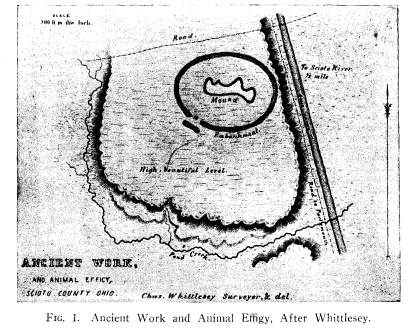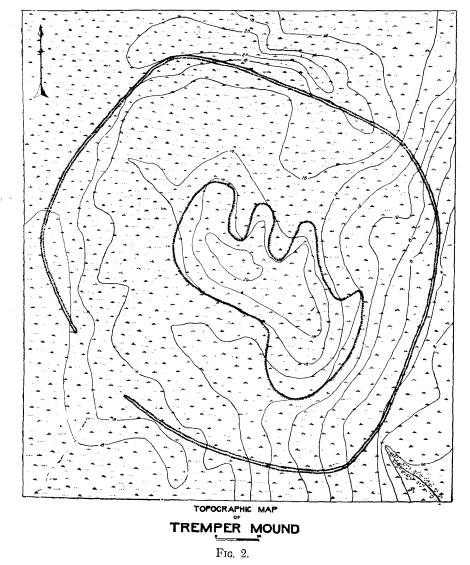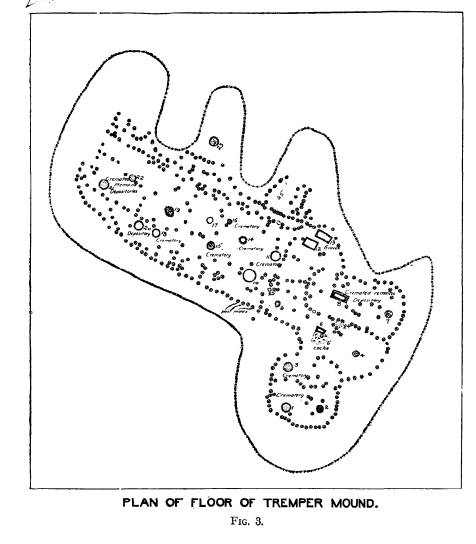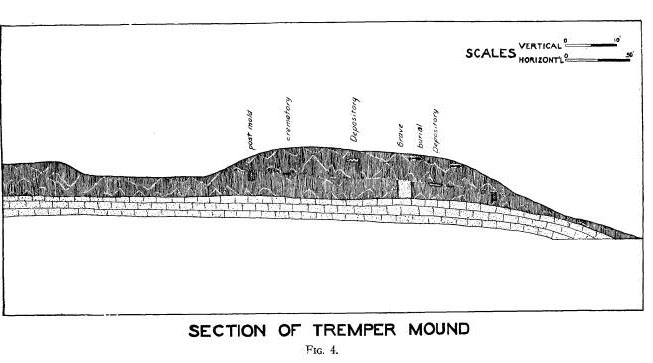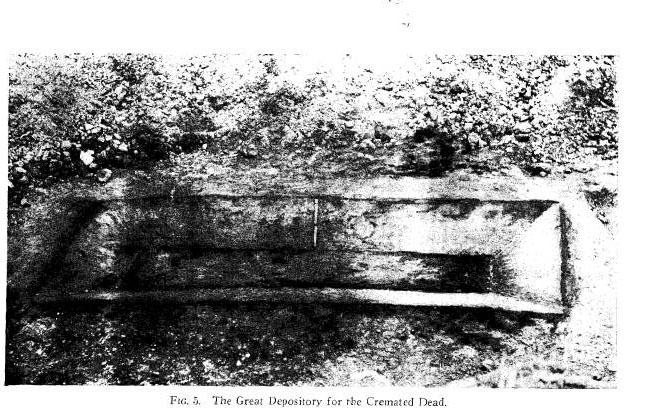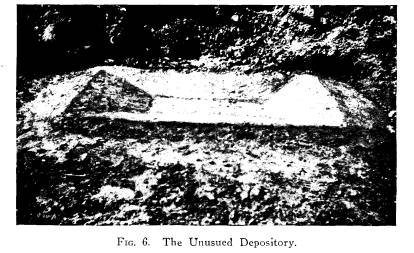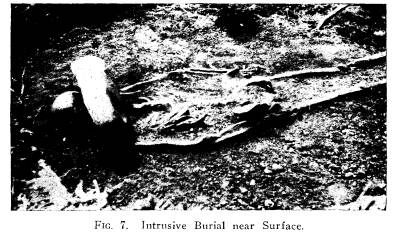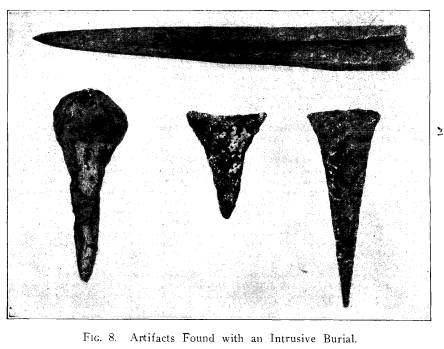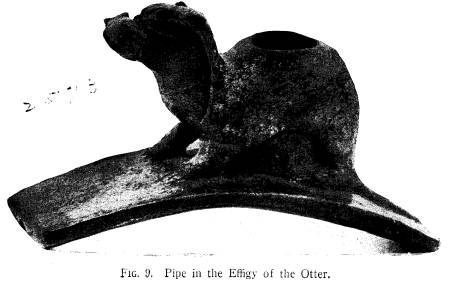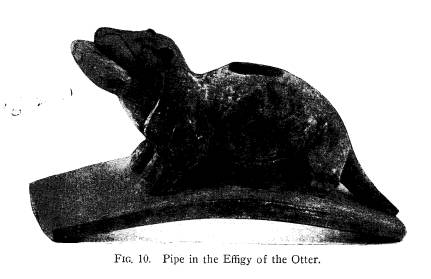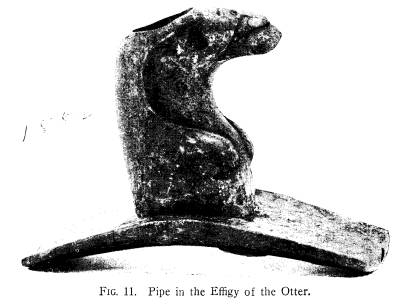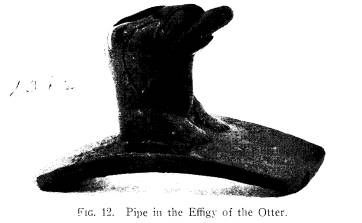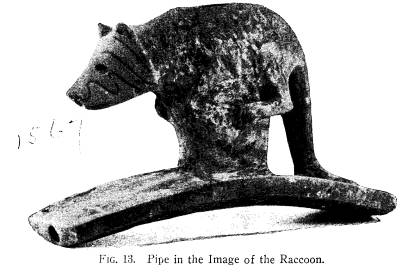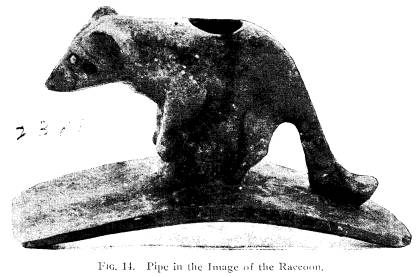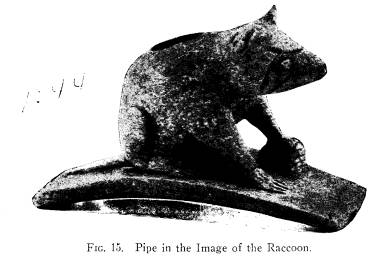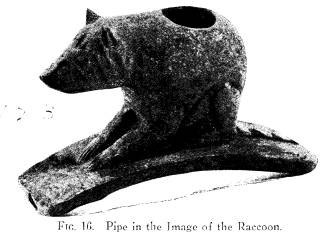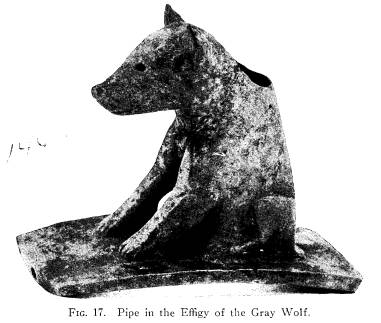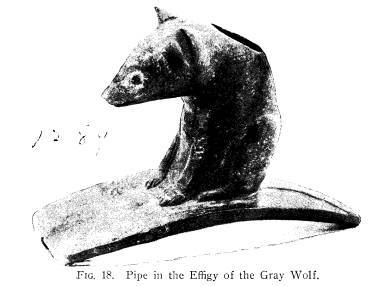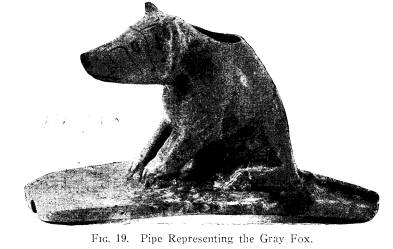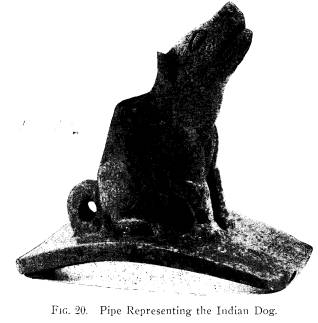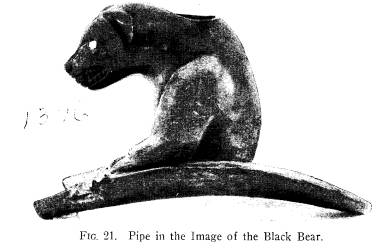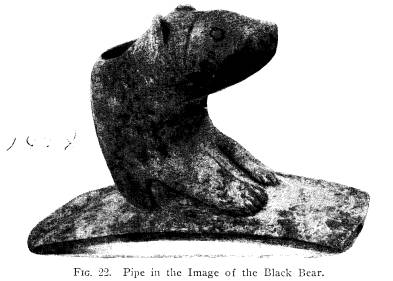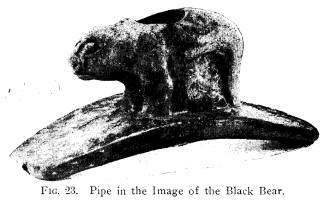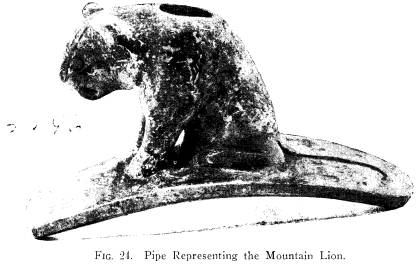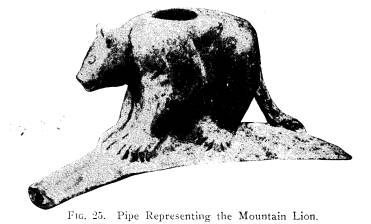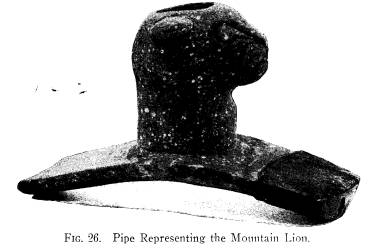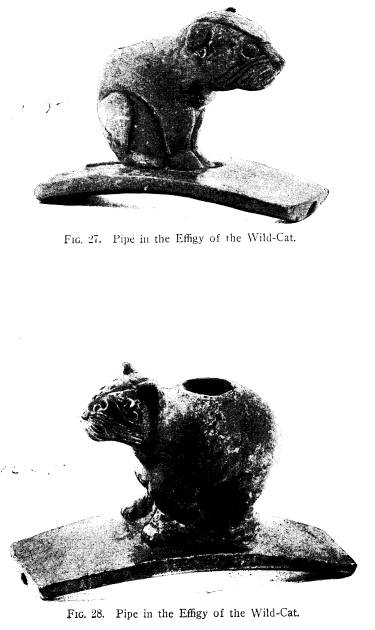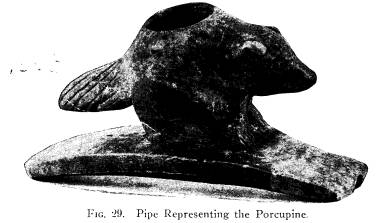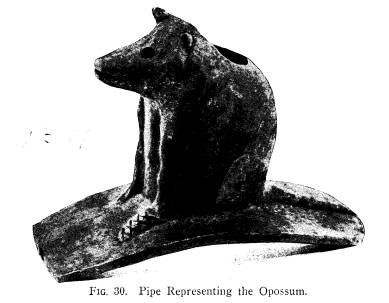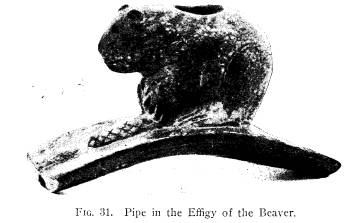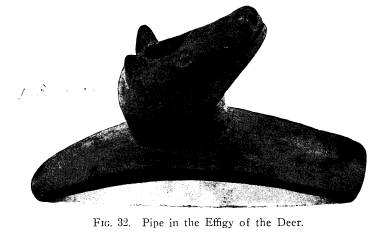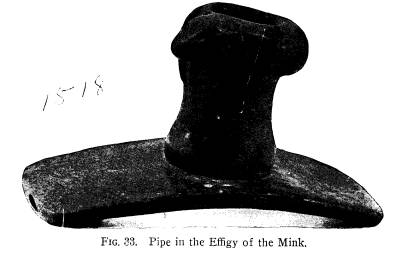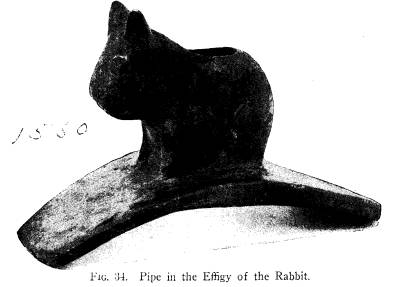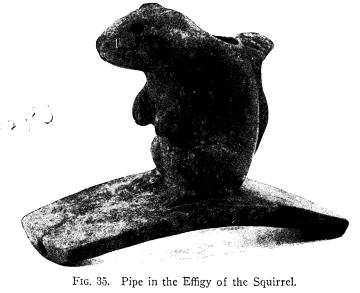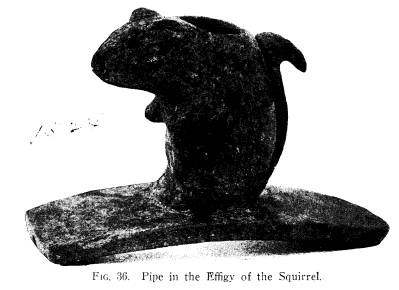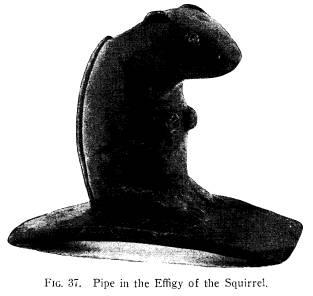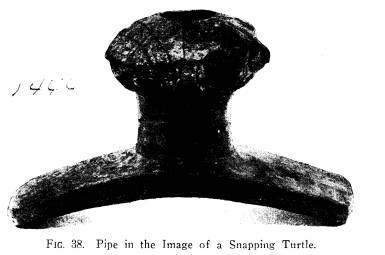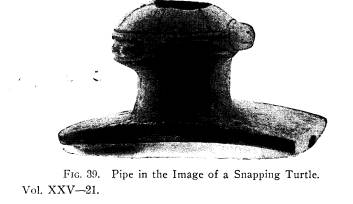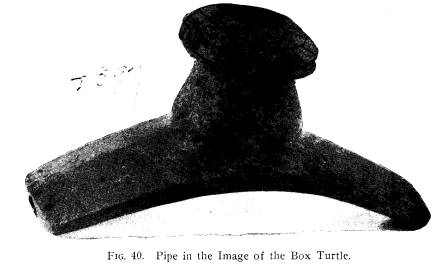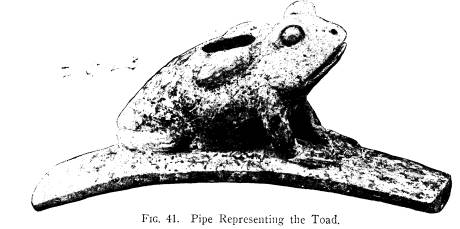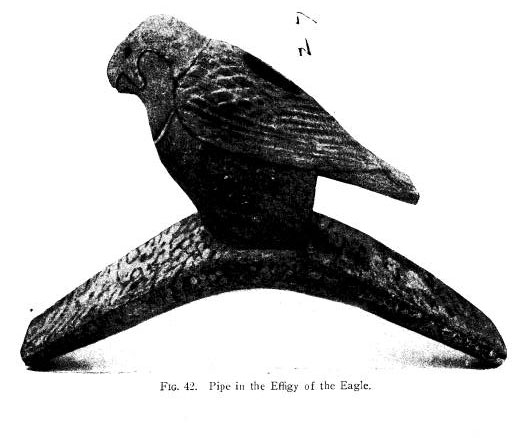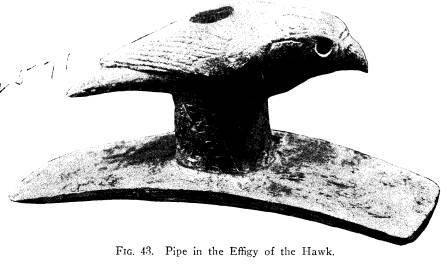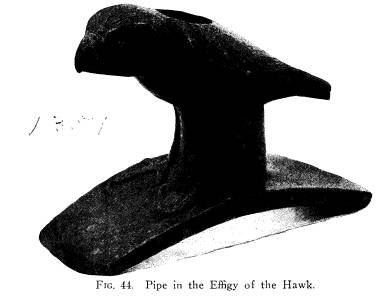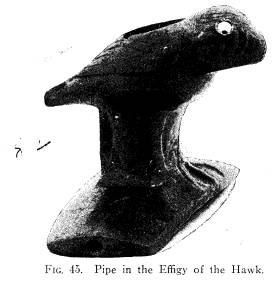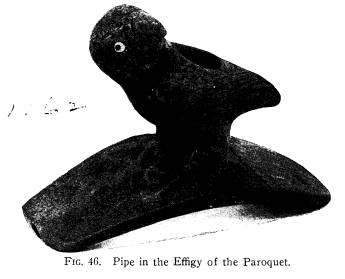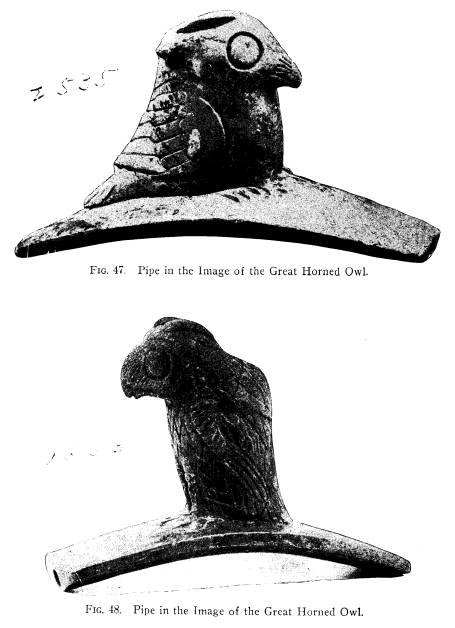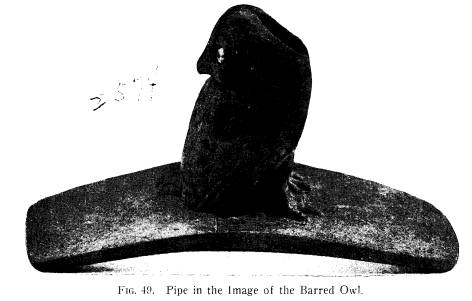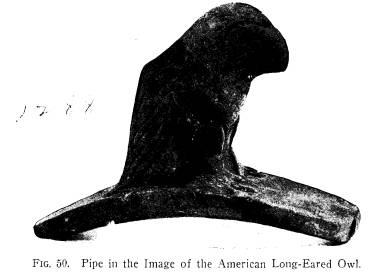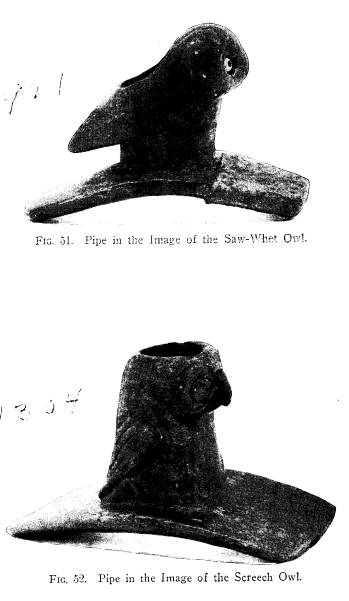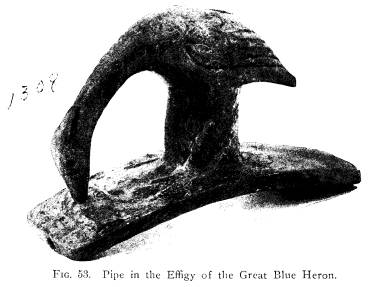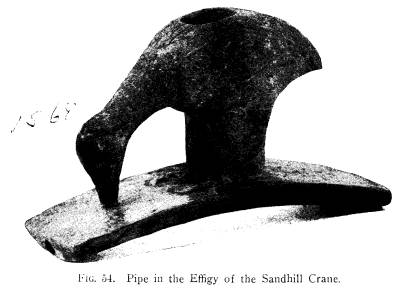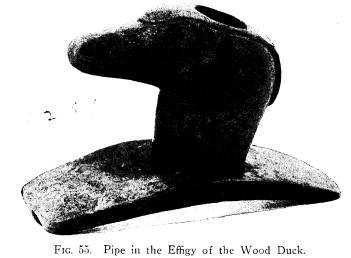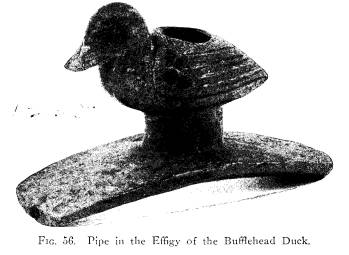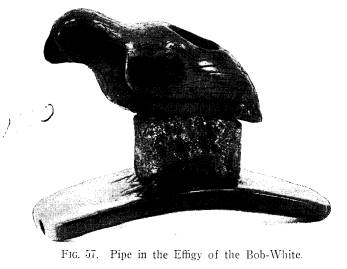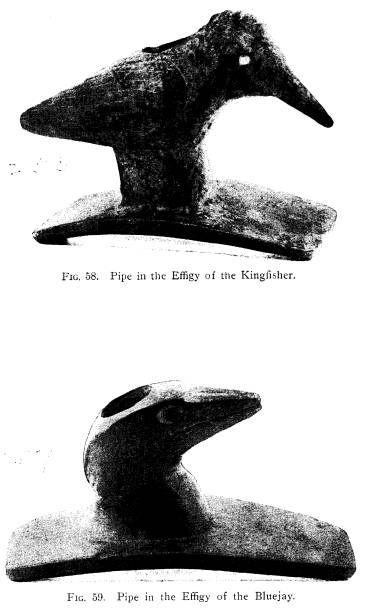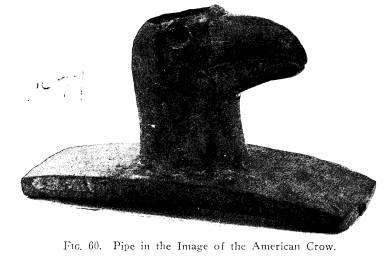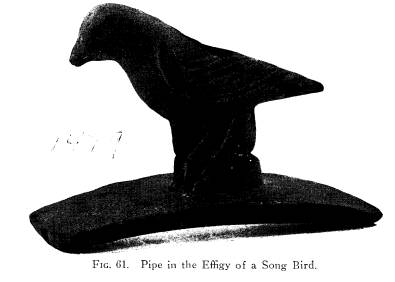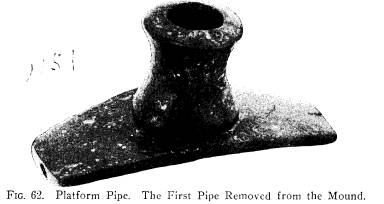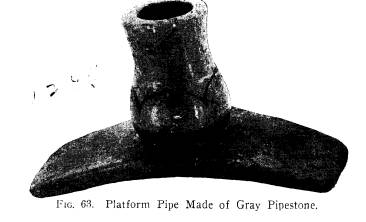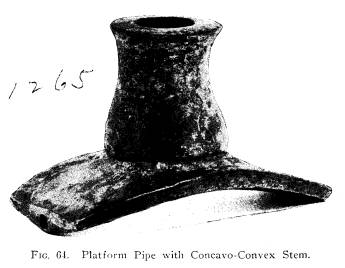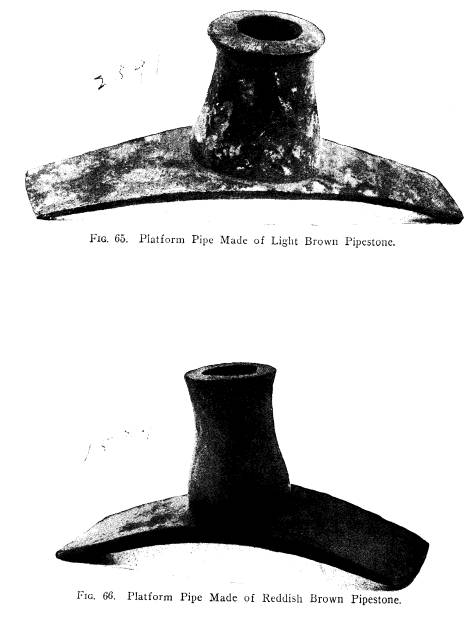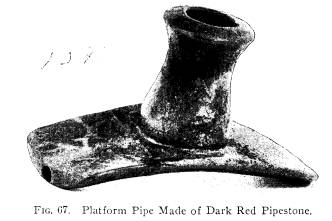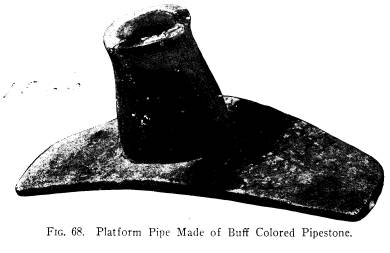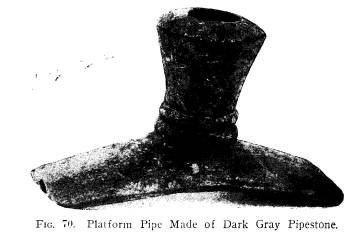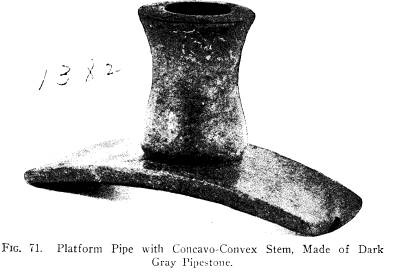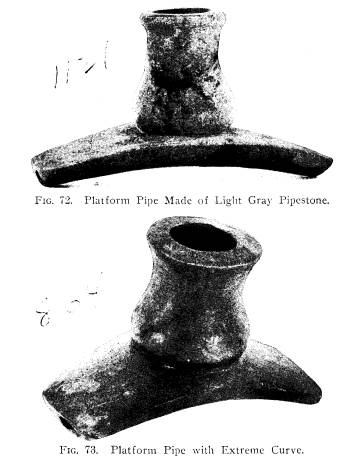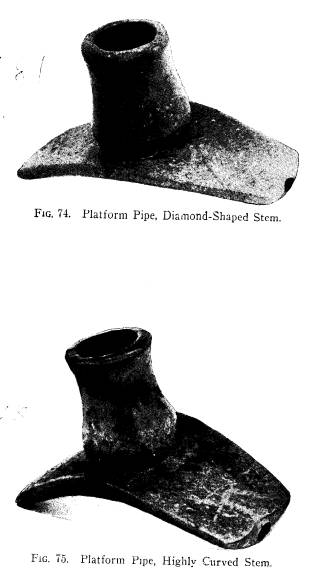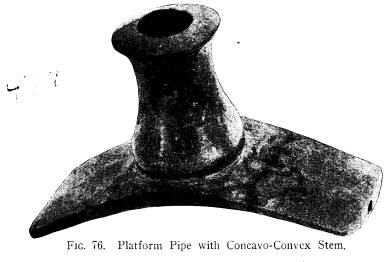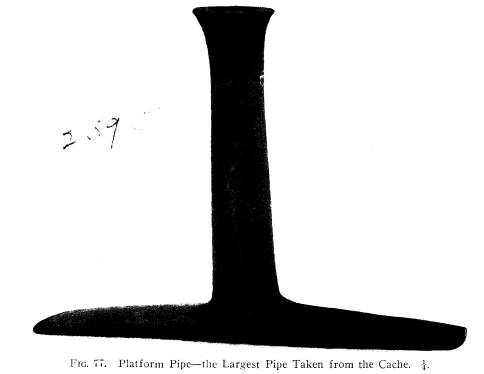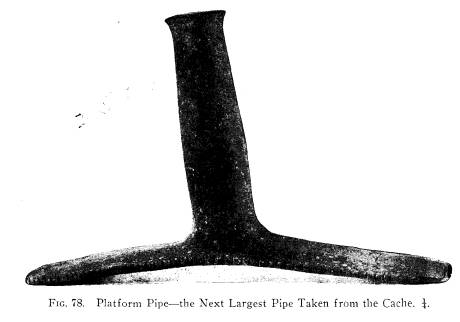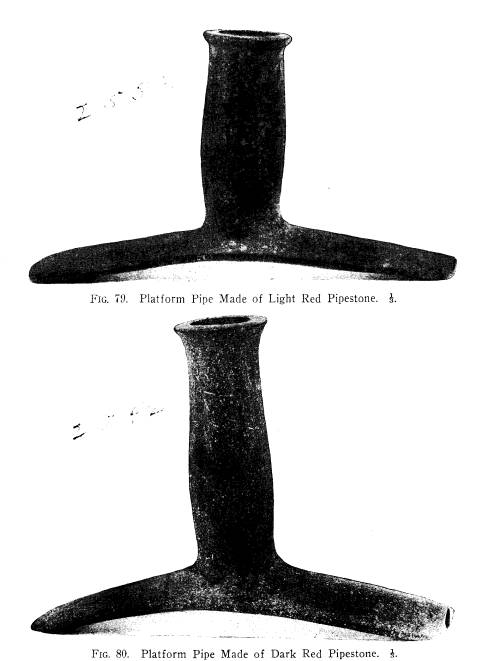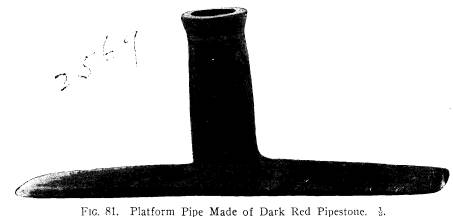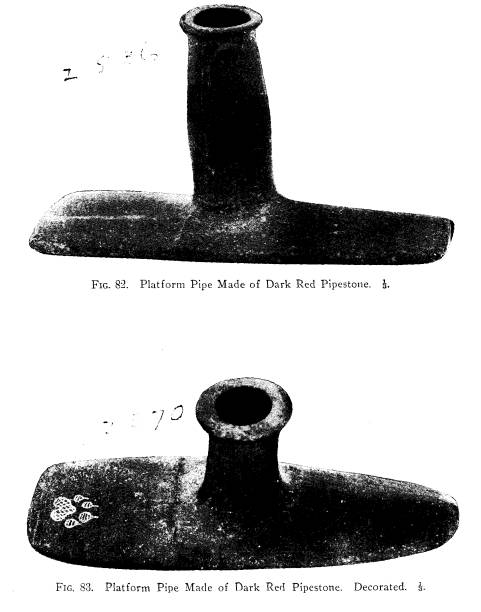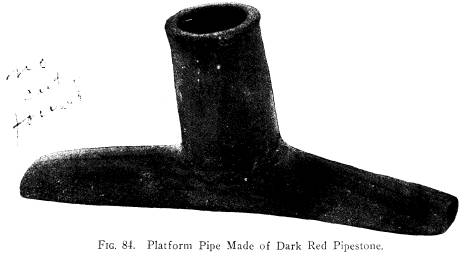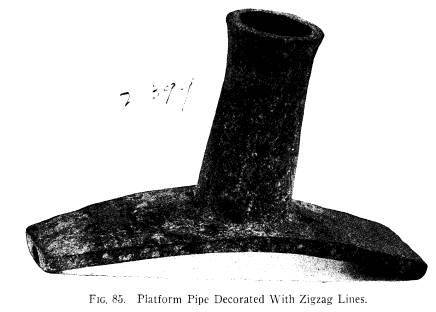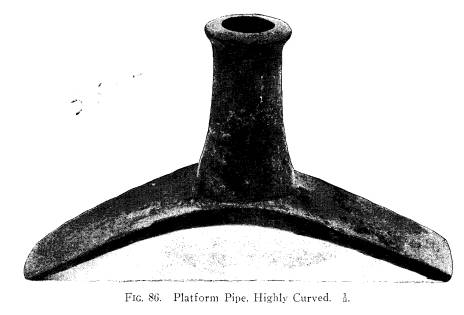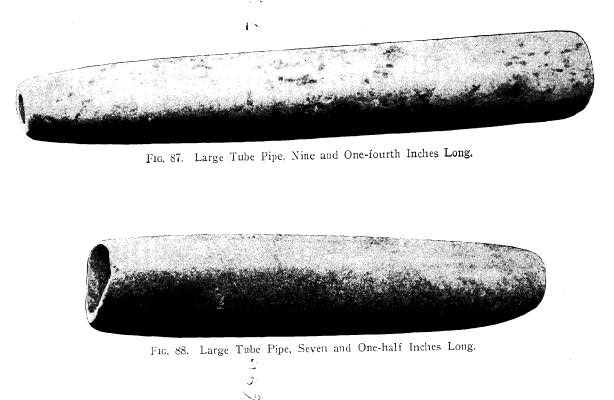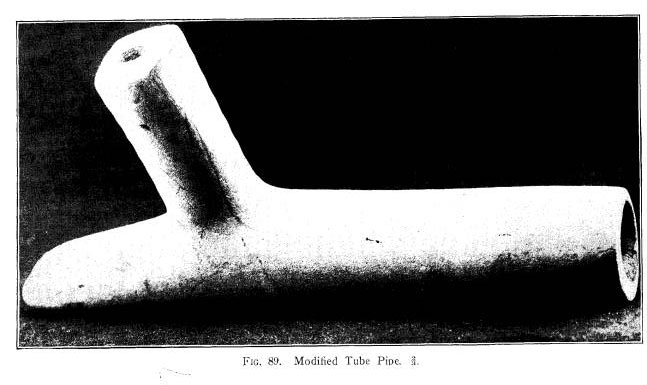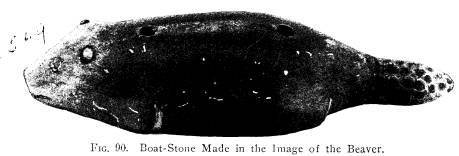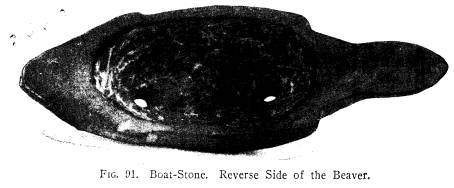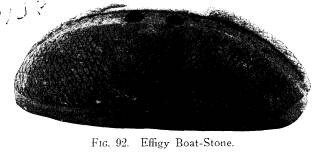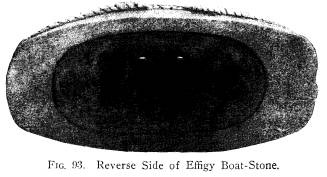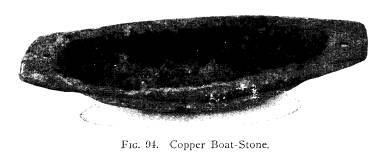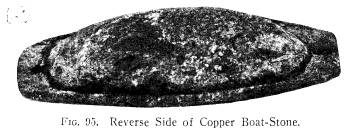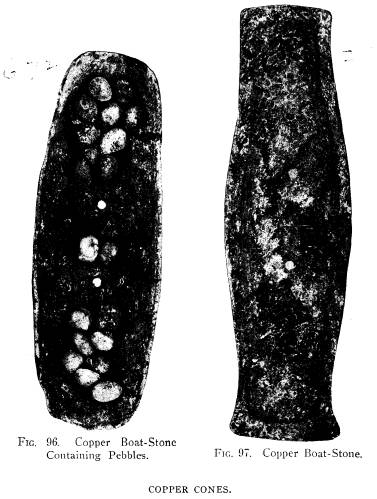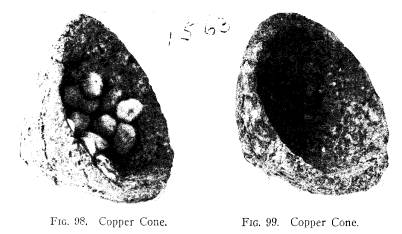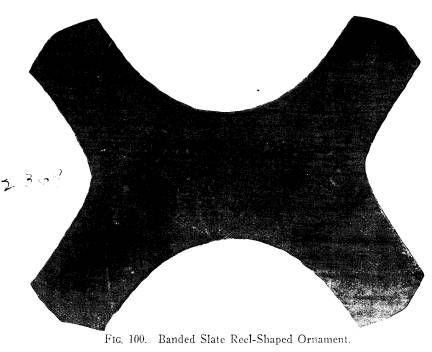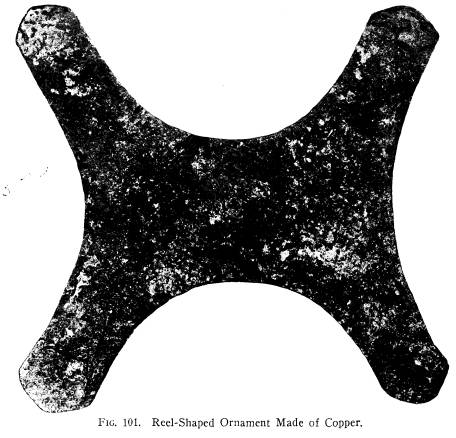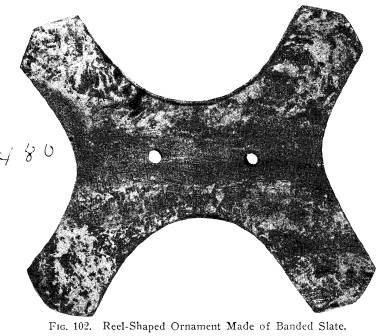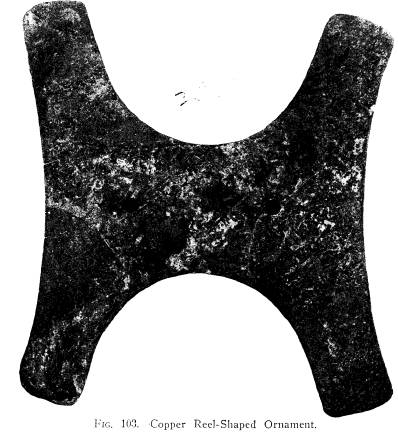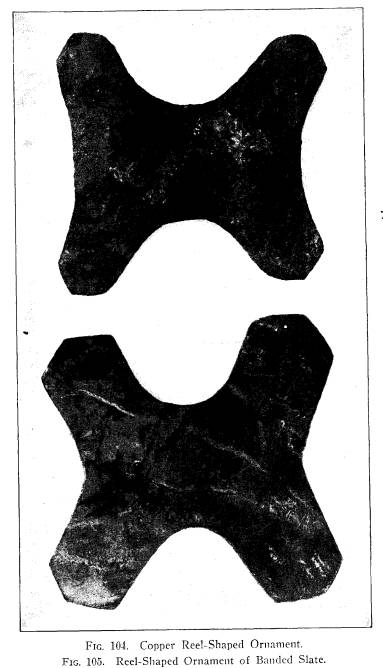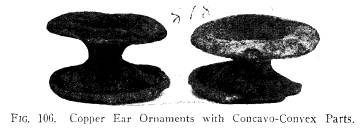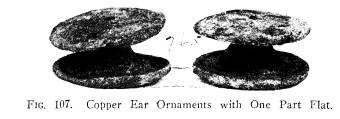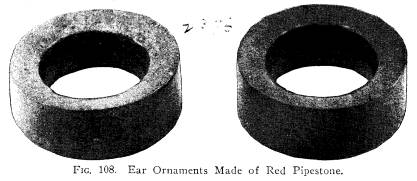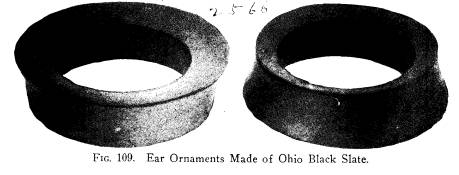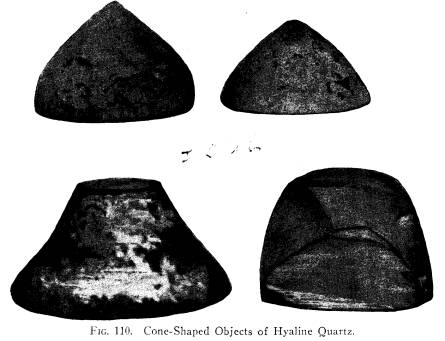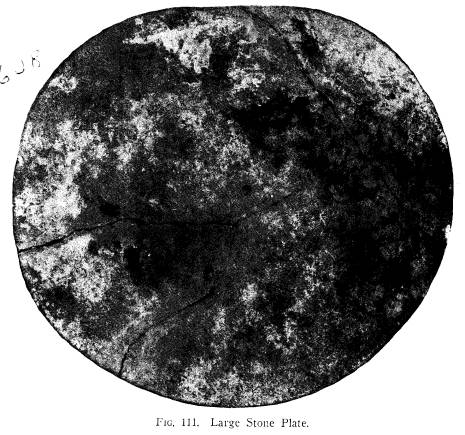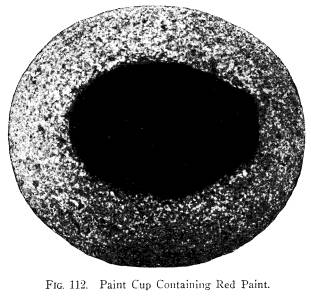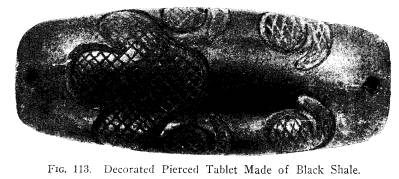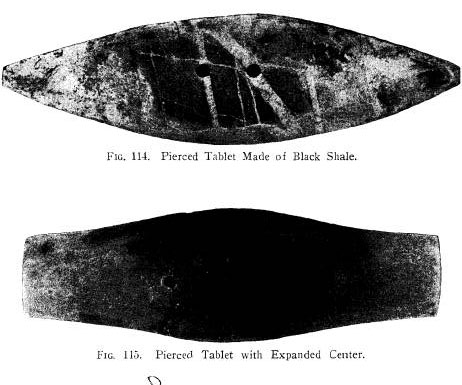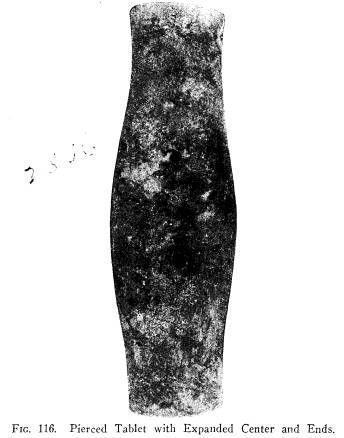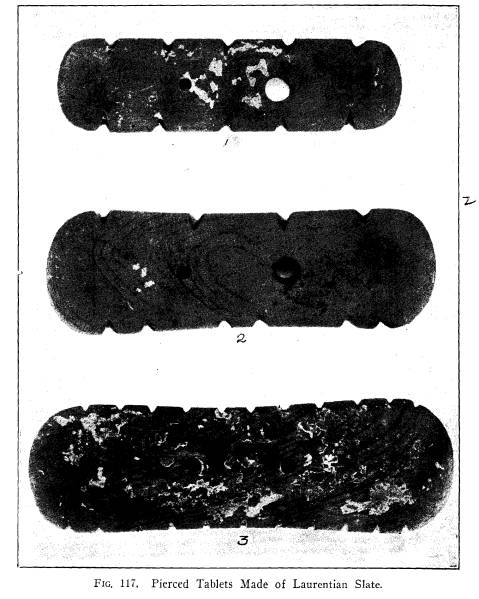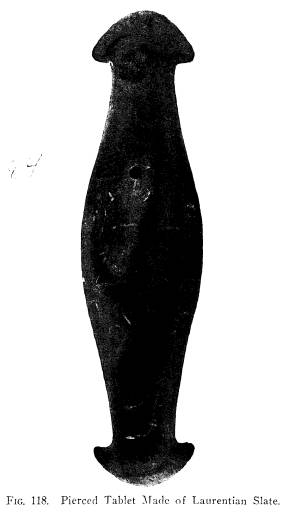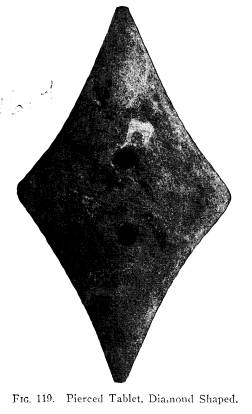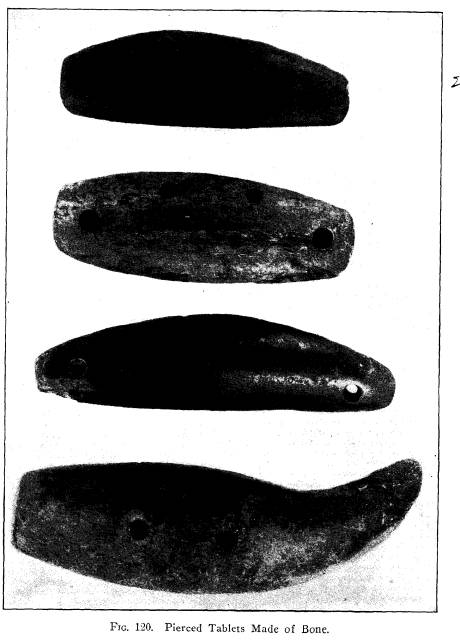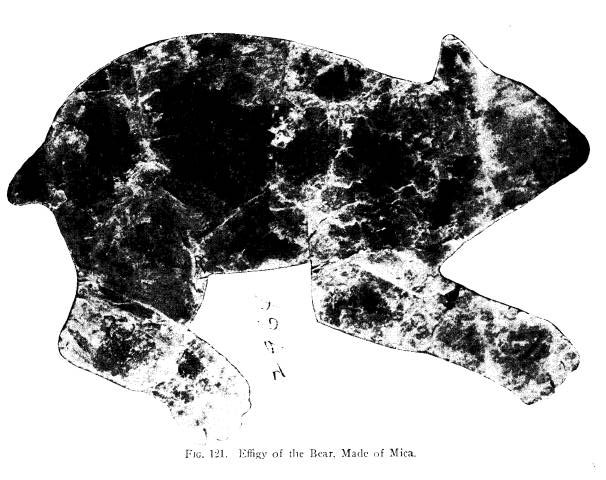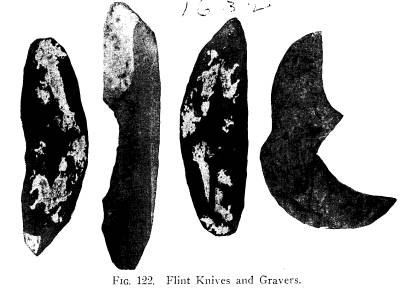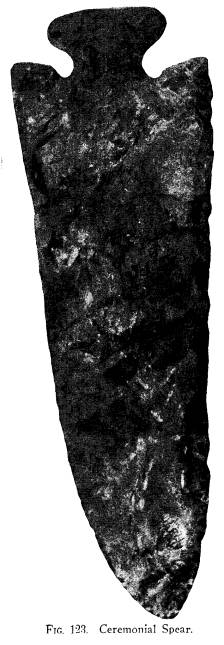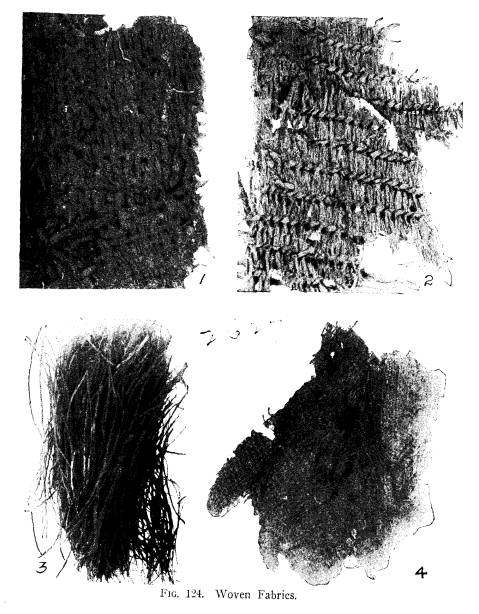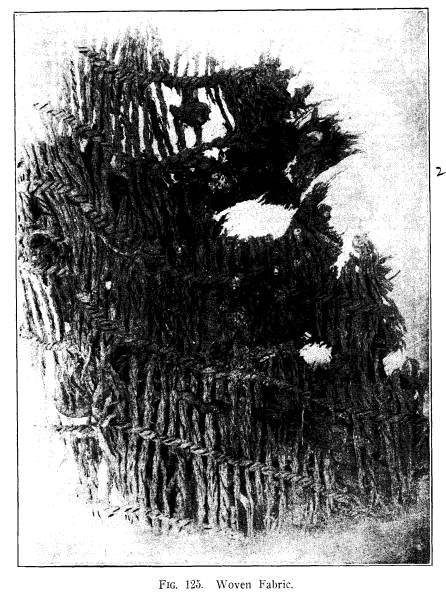Ohio History Journal
EXPLORATION OF THE
TREMPER MOUND.
WILLIAM C. MILLS.
The Tremper mound is situated five miles
north of the city
of Portsmouth, on the west side of the
Scioto river, in Rush
township, Scioto county, Ohio. The land
upon which it is located
is a part of the estate of Senator
William D. Tremper, Ports-
mouth, which consists of more than seven
hundred acres of the
rich bottom lands at the confluence of
the Pond creek and
Scioto valleys.
The immediate site of the mound is a
level plateau, about
seventy feet above low-water mark of the
Scioto river. Looking
westward from the summit of the mound
upon the narrow val-
ley of Pond creek, threading its way
between rugged hills up-
ward of five hundred feet in height, one
is impressed with the
powerful forces employed by nature in
carving out this narrow
water course, enabling the stream, fed
by innumerable springs,
to carry its surplus of pure cool water
to its junction with the
Scioto river. During glacial times, Pond
creek doubtless was
an outlet for the waters from melting
glaciers, pushing down
from the northwest, as well as for that
from icebergs incident to
the glacial period. These icebergs at
times doubtless resulted
in damming the flow of the torrent, and
an extremely interesting
illustration of this retarding influence
is to be seen just a few
hundred yards west of the mound. At the
point referred to a
most impressive natural amphitheatre,
semi-circular in form,
one thousand feet long and fifty feet or
more in height, marks
the site along the east side of the
valley of the stream where the
glacial flood, breaking the restraint of
the ice, has carved its
history.
At the intersection of the Scioto and
Pond creek valleys, and
just a short distance southwest from the
mound, is a fine spring
(263)
264
Ohio Arch. and Hist. Society
Publications.
of water. This spring doubtless played
an important part in the
life of the builders of the Tremper
mound and other aboriginal
dwellers, just as it has done in
supplying a never-failing source
of pure cold water to the early white
settlers of that section, to
their descendants, and to all who at the
present time pass along
the highway where it invitingly awaits
the thirsty traveler.
At the site of this spring, in an early
day, was located the
Buckhorn tannery, where General U. S.
Grant is said to have
worked for a short time. According to
Mr. Frank Johnson, who
was employed as a workman at the time of
the exploration of
the mound, his father, Lewis H. Johnson,
was foreman of the
tannery when General Grant was employed
therein.
THE TOPOGRAPHY OF THE COUNTY.
Scioto county, for the most part, is
broken and hilly. The
Scioto river flows directly through the
county, from north to
south, to its junction with the Ohio
river at Portsmouth. The
mouth of the Scioto is ninety feet below
the level of Lake Erie,
while its waters at Columbus are more
than three hundred feet
above, the low-water mark of the Ohio,
showing that the average
fall per mile between Columbus and
Portsmouth is more than
three feet. The valley of the Scioto is
the broadest and per-
haps the most fertile of any of the
rivers flowing into the Ohio.
The hills and ridges of Scioto county
are simply the rem-
nants of what once were continuous rock
strata, now chiseled
and sculptured by the tireless action of
water and other natural
agencies. Man has furthered the
transformation by denuding
the hills of their tangled forests, so
that on every hand instead
of woodland, are seen cultivated fields
and pasture lands.
GEOLOGY.
From an archeological viewpoint, Scioto
county presents
several interesting features as regards
geological formations.
Among these are the outcropping, along
the east bank of the
Scioto river, of the Ohio pipestone
(fired clay), and on the west
bank of the river of the Ohio black
shale, the latter underlying
the whole county.
Exploration of the Tremper
Mound. 265
The Ohio pipestone deposit extends over
the eastern part
of the county, beginning at the Scioto
river, where the outcrop
lies high up on the hills and gradually
dips to the southeast, and
continuing until in the eastern part of
the county the outcrop
lies low down near the base of the
hills. The pipestone stratum
varies in thickness from one and
one-half feet to eleven feet, the
average being three and one-half or four
feet. In color it varies
greatly, ranging from almost white,
through all the various
shades of color, to dark red. The dark
red variety is scarcely
distinguishable from the Minnesota
pipestone. The Ohio pipe-
stone was extensively used by
prehistoric man in this region for
making tobacco pipes. Of the one hundred
and forty-five pipes
taken from the Tremper mound, all but
four were made from
that material, the exceptions being
three of coral limestone and
one of fine-grained sandstone.
The Ohio black shale is the lowest
stratum exposed in the
county. It outcrops along the west bank
of the Scioto river. In
color it is very black, is fine grained,
high in carbon, and crumbles
after long exposure. The shale was used
by prehistoric man in
making gorgets and other ornaments found
in the mound.
HISTORICAL DATA ON THE MOUND.
The Tremper mound has been in the
possession of the
Tremper family for many years. The base
of the mound never
had been disturbed, as the owners were
unwilling that the mound
should be examined, except under the
auspices of the Ohio
State Archaeological and Historical
Society, and for the benefit
of the state. Several years ago, Senator Tremper's sons,
Richard and William Tremper, made a
superficial examination
by digging into the top of the mound at
several points, finding
a number of skeletons buried not more
than one foot below the
surface. These burials doubtless were of
an intrusive nature,
as was shown by the finding of five
additional and entirely
similar burials in the exploration of
the mound, but which differ
greatly both in mortuary customs and
artifacts from those of
the real builders of the mound.
The first published account of the
Tremper mound is found
in "Ancient Monuments of the
Mississippi Valley", by Squier
|
266 Ohio Arch. and Hist. Society Publications. and Davis, 1846, page 83, with a drawing of the mound, shown as plate 29, after the survey of Charles Whittlesey. The work is designated as an "Ancient Work and Animal Effigy, Scioto county, Ohio". Mr. Whittlesey's drawing is herewith repro- duced, as Fig. I, for comparison with the drawing, Fig. 2, made by Mr. George H. Miehls, surveyor for the Society's field ex- plorations. In their description of the Tremper mound Squier & Davis say: |
|
|
|
DESCRIPTION BY SQUIER & DAVIS. "This singular work is situated five miles north of Ports- mouth, Scioto county, Ohio, on the west bank of the Scioto river. It is not a true ellipse, but approaches very near it. Its longest axis is four hundred and eighty feet, its conjugate diameter four hundred and seven feet. It is built upon a high and beautiful level, elevated some sixty or seventy feet above the Scioto river, which flows about half a mile to the eastward. |
Exploration of the Tremper
Mound. 267
The embankment is unaccompanied by a
ditch and is about
three feet in height, by thirty feet
base. It has, as shown in
the plan, a single gateway, ninety feet
wide, opening to the
south-east, which is covered by a long
exterior mound, of about
the same height with the embankment of
the enclosure.
"Within this enclosure is a large
irregular mound, which
from its resemblance to the
animal-shaped mounds of Wis-
consin, of which notice will be taken in
another place, constitutes
by far the most interesting feature of
the work. It is of the
form and relative size indicated in the
plan, and is composed of
loose broken sandstone and earth, based
upon dislocated and
broken sand-rock. It is from one to
eight feet high, being
lowest at the eastern end or head, and
at the projecting points.
It is probably of the same design with
those of Wisconsin,
already alluded to, which occur in great
numbers and in long
and apparently dependent ranges. None of
those, however, so
far as known, are found enclosed after
the manner of the one
here presented. No explanation of the
probable design of this
work will be attempted here: it is
impossible, however, to dis-
connect it from the superstitions of the
ancient people. An
interesting fact is communicated by F.
Cleveland, Esq., of
Portsmouth, who assisted Mr. Whittlesey
in making the survey
of this work, and who was engineer on
the Ohio canal when it
was in progress; viz., that the workmen
engaged in excavating
found large quantities of mica, in
sheets, in the immediate
vicinity of this enclosure. This mineral
is found in great
abundance in the mounds and in the
neighborhood of these
ancient works."
Mr. Gerard Fowke in his
"Archeological History of Ohio,"
ventures to call the Tremper mound
"The Tapir", but states
that "Ohio possesses several of
these effigies, only two of which
really resemble anything,"
referring to the great Serpent mound
in Adams county and the Opossum mound in
Licking county.
THE MOUND FROM AN EXTERNAL VIEWPOINT.
The opinion of Squier & Davis, as
expressed in the second
paragraph of the above quotation, to the
effect that the Tremper
mound probably was an effigy mound of
the same design as
268
Ohio Arch. and Hist. Society Publications.
those of Wisconsin, was perhaps a
natural conclusion, in view
of their observations and of what up to
that time was known
of the mounds and their purpose.
As the result of several visits to the
Tremper mound within
the past dozen years for the purpose of
examining the general
form and surroundings of the work, I had
fully decided that the
mound was not intended as an effigy of
an elephant or of any
other animal, but was very likely a
burial mound belonging to
the Hopewell culture. In many respects
it resembled the Seip
mound,* along Paint creek, in Ross
county, its irregular form
apparently being due to additions made
to the great charnel-
house. This opinion is borne out by our
present examination,
which shows that the Tremper mound was
not intended as an
effigy of any kind, but that its shape
was entirely the result of
additions to the main site or structure,
made and completed as
needed.
According to Squier & Davis, who
published the survey
made by Charles Whittlesey, which is
shown in Fig. I, the
earthwork is an almost perfect ellipse,
with an extra wall closing
the opening to the south-west. By
referring to the topographic
map made by our survey, Fig. 2, it will
be seen that the early
surveyors very likely used no
instruments in making these sur-
veys. It would seem that they made
certain measurements
from the mound center, and drew on paper
what appeared to
them to be the general form of the
earthwork. It is true that
one standing on the mound and viewing
the earthwork from
that viewpoint, receives the impression
of an almost perfect
ellipse; but the present survey found
the earthwork to be a
round-cornered rectangle, practically
four hundred and twenty
feet by four hundred and forty feet in
size. Special inquiry
among old residents concerning a
possible embankment in front
of the entrance to the earthwork,
elicited the information that
to their knowledge no earth had been
hauled away, and our
survey could find no trace of there ever
having been a wall in
front of this opening.
* Explorations of the Seip mound found
in "Certain Mounds and
Village Sites in Ohio." Vol. 2,
Part 1. Mills, 1909.
270
Ohio Arch. and Hist. Society Publications.
THE EXPLORATION OF THE MOUND.
On the 2Ist of July, 1915, was begun the
exploration of
the Tremper mound. The examination had
as its purpose the
exposing to view of the entire site of
the mound, the recording
of all finds, and the photographing of
all important features.
The surveyor of the party, Mr. George H.
Miehls, made a
complete survey of the mound and the
earthwork that surrounds
it before excavating was begun, and from
his notes was prepared
the topographic map shown in Fig. 2. He
then established
secondary traverse points upon and
around the mound, and
from these located, by the aid of the
instrument, the various
finds in the mound as they were
unearthed, and from his notes
prepared the map, Fig. 3, showing the
plan of the floor of the
mound. Mr. Miehls also prepared a plan
showing a cross-
section of the mound, upon which was
recorded the depths of
finds therein, as well as the depth of
the soil composing the
mound and of graves found below its
base. The cross-section
is shown in Fig. 4.
The maximum length of the mound as shown
by our survey
is two hundred and fifty feet and the
maximum width one
hundred and fifty feet, with an average
width of one hundred
and twenty feet. Its maximum height is
eight and one-half
feet, with an average height of about
five feet. The solid con-
tents of the mound are approximately
three thousand cubic
yards of earth, all of which was
examined, after which the
mound was restored to its original
height and dimensions.
The surface of the mound had long been
under cultivation
and was devoid of trees or undergrowth,
which greatly facilitated
its examination. For the most part, it
was constructed of sur-
face soil secured in close proximity to
the mound site, and
within the encircling earthwork. Squier
& Davis state that the
mound is composed of loose broken
sandstone and earth; we
found but few pieces of sandstone, these
occurring only in con-
nection with intrusive burials. Within
the body of the mound,
now and then, small pockets of gravel
were unearthed, while
the central portion of the floor,
surrounding the large communal
grave and the cache of artifacts, was
covered with fine sand to
the depth of several inches.
Exploration of the Tremper
Mound. 273
The work of examining the mound was
greatly retarded
by frequent rains, the trenches at times
being filled with water,
so that much time was lost placing them
in condition to con-
tinue. The floor or base of the mound
sloped to the southeast,
the drainage consequently being in that
direction. As a result
that portion of the mound was wet, a
condition which retarded
our examination and very often
interfered with the critical
inspection which is always given to
every portion of a mound
while the workmen are engaged in its
removal. The remarkably
distinct floor, which in every part of
the mound was readily
distinguishable from the earth composing the mound itself,
greatly facilitated the locating of the
rows of postmolds, mark-
ing the outline of the structure, as
well as of the various rooms
and compartments thereof.
Approximately six hundred of these
postmolds were noted.
Many of them were clean cavities
extending both below and
above the floor line, this condition
being found where the posts
had not been entirely consumed in the
burning of the structure,
leaving them gradually to decay, their
places being marked only
by the hollow mold. In other instances,
the proof of the burn-
ing of the structure when its purpose
had been served, and
preparatory to the erection of the
mound, was seen in the partly
burned and charred posts. These were
present both in the
molds, at the floor line, and also where
they had fallen during
the conflagration, and had been covered
before they were con-
sumed. Specimens of the charred sections
of posts were taken
out intact and placed on display in the
Museum.
SITE OF THE MOUND A SACRED PLACE.
The work of exploration soon disclosed
that the Tremper
mound is of the great Hopewell culture,
but, with the possible
exception of Mound No. 8, Mound City
group, differing in
several important particulars from
mounds of that culture
already explored. These differences,
which presented them-
selves as the work of excavation
progressed, were the depositing
of the ashes from the crematories in
communal depositories,
the burial of cremated remains beneath
the base line of the
mound, and the placing of the artifacts
of the dead in common
Vol. XXV-18.
274
Ohio Arch. and Hist. Society Publications.
caches. In this last respect, Mound No.
8, Mound City group,
was analogous, and it is probable that
the communal idea ex-
tended also to the disposition of the
cremated remains, although
this, as well as interment of cremated
remains below the base
line, cannot at present be determined,
as the explorations of
Squier & Davis in that mound were of
so desultory a character
as to preclude any very definite or
extensive information.
Therefore, insofar as actual information
goes, the communal
character of burial and the sub-base
interment of cremated re-
mains are features exclusively of the
Tremper mound.
As is to be expected in mounds of the
Hopewell culture, it
was found that the site of the Tremper
mound had been occu-
pied by a structure serving as a sacred
place, in which the dead
were cremated, their ashes deposited in
prepared receptacles,
and the doubtless intricate ceremonials
accompanying these pro-
ceedings, including the depositing of
implements and ornaments
of the deceased, were carried out. The
structure proper had
been a large oval enclosure,
approximately two hundred feet
long and half as wide. A number of
chapel-like additions,
possibly to afford more space or to
supplement that of the main
structure, had been built from time to
time. Upright posts
averaging six inches in diameter, set
into the ground to a depth
of about two and one-half feet, formed
the outer walls of the
complex structure, as well as the
partitions separating them into
various compartments. The remains of a
sort of wattlework,
woven of twigs and limbs was found,
which doubtless had been
used to close the interstices between
the upright posts, which
were set about three feet apart. The
floor of the area com-
prising the sacred structure had been
carefully leveled and
smoothed, and in places fine sand had
been spread out over it.
Doubtless parts of the structure at
least had some sort of roof
or thatch, as indicated by the
arrangement of certain of the
posts, but no direct evidence of the
existence of such a roof
was found.
Reference to the map shown in Fig. 3,
"Plan of Floor of
Tremper Mound," explains the
arrangement of the structure
into rooms or compartments. The
postmolds indicate the out-
line of the entire building and of the
additions, as well as various
Exploration of the Tremper
Mound. 275
partitions and supports. The more
important of the additions
to the main structure, it will be noted,
were on the east and
southeast, with others, in the nature of
passageways and en-
closures, with openings leading to the
interior, principally along
the north side. There appear to have
been several openings at
the extreme west end. It was the
covering over with earth of
these secondary additions, in
constructing the mound, which
gave it the anomalous shape suggesting
the erroneous idea of
an intentional animal effigy.
SPECIAL FUNCTIONS OF THE COMPARTMENTS.
The great room comprising the central
and western portion
of the structure, and particularly the
south side thereof, was
devoted entirely to the care of the
dead. Here the greater
number of the crematories were located,
as well as several small
depositories. Of the three large
circular additions built onto
the east end of the structure, the most
southerly, forty-five by
fifty feet in size, contained three
large crematories, and appar-
ently was given over entirely to the
purpose of cremation. The
floor of this room was covered to a
depth of about one inch with
charred leaves and straw.
The room directly north, being the central
one of the three
additions at the east end of the main
structure, appears to have
been given over entirely to the great
cache of pipes and asso-
ciated artifacts, described elsewhere.
It contained however, in
addition to the cache, a rectangular
prepared basin or depository,
unused, a cremated burial of a single
individual, and a large
fireplace. In this room, the floor of
which had been covered
with sand, no posts had been placed
interiorly. This provided a
large space around the fireplace,
entirely clear from obstruc-
tions, a condition not noted in any
other part of the structure.
The room just north of the one
containing the cache, held
a very large prepared depository for the
ashes of the dead, and
a large fireplace. This room doubtless
was the main vault, in
which the greater part of the cremated
remains from the entire
structure were deposited.
The smaller additions along the north
side appear to have
been mainly in the nature of long
passageways and small rooms.
276
Ohio Arch. and Hist. Society Publications.
The floors of these, in great part, were
covered with charred
leaves, cloth and other charred
substances, strewn in places to
a depth of several inches. The most
definitely outlined of these
rooms along the north side, is that
shown as number 25, in
Fig. 3. This room appears to have been a
veritable workshop
and kitchen, the floor being strewn with
the bones of animals,
such as the deer, elk, bear, turkey and
raccoon. None of these
bones had been worked, but all were
broken, indicating the use
of the animals as food. Broken pottery,
apparently associated
with the preparation and storing of
food, was also abundant
on this floor, as was Ohio black shale,
in pieces of a size sug-
gesting their use in the making of
ornaments. Practically the
entire floor of this room was covered
with mica flakes, in size
from the smallest bits to fragments an
inch or more in diameter,
many of them apparently refuse from the
large crystals of mica
found in the great cache.
To the southeast of this room, and
adjacent thereto, was a
room, below the floor of which were
found the two graves con-
taining cremated burials, and described
elsewhere.
Study of the map of the floor plan and
of the data per-
taining to the mound, enables one to
picture rather vividly, the
activities, carried on doubtless through
a considerable length of
time, of its builders in disposing of
their dead.
DISPOSITION OF THE DEAD.
Cremation was an exclusive practice with
the builders of
the Tremper mound, not a single instance
of uncremated burial
being recorded. The uncremated burials
found near the top of
the mound, and described elsewhere, were
of an intrusive nature,
and did not pertain to the culture responsible
for the building
of the mound.
The crematories were identical with
those found in the
Harness and Seip mounds, and others of
the same culture ex-
plored. They were twelve in number, and
were scattered gen-
erally through the structure. All showed
evidence of long-
continued use, and in most of them the
presence of charred
human remains was noted. They were most
in evidence in the
Exploration of the Tremper
Mound. 277
large room, at the south center of the
structure, which seems
to have been especially set apart for
this purpose. The
crematories were basin-shaped, many of
them quite deep. The
earth beneath them was burned red for a
depth of almost one
foot.
DISPOSAL OF CREMATED REMAINS.
The placing of the ashes of the dead in
prepared com-
munal depositories was the rule with the
builders of the mound.
The exceptions were two cremated burials
below the floor of
the mound, and two individual cremated
burials. The com-
munal depositories, peculiar to the
Tremper mound, were four
in number, consisting of a main
depository, located in the east
end of the structure, and three smaller
ones, in the western end.
These communal graves correspond in use,
and to some extent
in form, to the prepared graves of the
Harness, Seip and other
mounds of this culture explored, with
the distinction that they
served to contain, not a single burial
or one consisting of the
remains of a few individuals, as in the
Seip mound, but an
unlimited number of burials.
The depository numbered 8 in Fig. 3, and
pictured as Fig.
5, was made of fine puddled clay, which
after being worked
into place was burned. The clay was
applied with the hands.
imprints of fingers being visible, as
were also marks of the
digging stick used in tamping down and
shaping the sides of the
basin. The depository was in the form of
a parallelogram, ten
feet and three inches long, and five
feet wide, with a central
depth of six inches. The bottom measured
six feet and six
inches long by thirteen inches wide, its
surface being perfectly
flat and level. The grave was filled
with human ashes and
charred bone to a depth of a little more
than one foot; these
ashes however, were very compact, and
originally must have
been piled high above the rim of the
basin. The contents of
the depository no doubt represent the
remains of hundreds of
cremated bodies, indicating the use of
the grave for a long
period of time. The floor surrounding
the great basin was
covered on the south and west sides with
fine yellow sand, and
on the east and north sides with bits of
charcoal and ashes
mixed with clay.
|
Exploration of the Tremper Mound. 279
The three small depositories, shown as 20, 21 and 22, in Fig. 3 were not specialized as was the large one, but were merely prepared bases of clay. The ashes of the dead were piled upon these flat bases to a depth of two and one-half inches in No. 20; two inches in No. 21 and three inches in No. 22. A specialized depository (No. 6, in Fig. 3) was found near the great cache, but it contained no cremated remains and appar- ently never was used. In form it was very similar to the large grave, and measured five feet and three inches in length and two feet and five inches in width, outside measurements. |
|
|
|
A comparison of the mortuary customs of the Tremper mound builders with those of the Harness and Seip mounds, shows the great advantage of the communal plan of the former. In the use of individual prepared graves, as in the Harness mound, or in the Seip mound where the graves occasionally were enlarged so as to hold as many as four cremated bodies, the available space soon would be exhausted, while under the communal grave plan, the number of cremations that could be placed in one depository was limited only by the size of the depository. Additional depositories, moreover, could easily be constructed, making the Tremper mound plan of burial much superior. |
280
Ohio Arch. and Hist. Society Publications.
ESTIMATED NUMBER OF CREMATIONS.
There is no way of exactly ascertaining
the number of
dead contained in the four depositories
of the Tremper mound.
The bulk of ashes and charred bones was
computed at twenty-
five cubic feet, which, allowing
one-fifteenth of a cubic foot to
each burial, would represent the
cremation of three hundred
and seventy-five individuals. No doubt
this is far short of the
total number of dead cremated, as the
floor of the charnel-
house was strewn with ashes and
fragments of charred human
bones.
An individual cremated burial was found
in the room con-
taining the great cache, and is shown as
No. 24 in Fig. 3. This
burial appears to have been of
considerable importance, as it
was placed in the angle formed by the
joining of two walls, and
a row of small posts placed around it. A
second individual
cremated burial was found in this room,
about two and one-half
feet above the floor. With the charred
remains was a flint
spearpoint, six inches long.
BURIALS BENEATH FLOOR LEVEL.
A feature peculiar to the Tremper mound
was the finding
of cremated burials beneath the floor.
These are shown as 12
and 13 in Fig. 3. The two graves were
three and one-half feet
deep, the floors being the surface of
the undisturbed sandstone
strata underlying the site. Their
dimensions were seven feet
long and three feet wide, and seven feet
long and five feet
wide, respectively. The first grave, No.
12, contained
only a
small amount of ashes and charred
remains, and no artifacts
of any kind. The second grave contained,
besides the cremated
remains, four copper ear ornaments, mica
cut into the form of
crescents, a mica effigy of the bear,
and a small flint spearpoint.
PRIMITIVE MASONRY.
A special feature of this grave was a
wall of thin slabs of
sandstone at the sides and ends of the
grave, completely lining
it, and forming a vault-like receptacle,
with perpendicular walls.
As far as recorded this is the only
instance of a regularly laid
Exploration of the Tremper
Mound. 281
up wall of stone, constructed by
aboriginal man in Ohio. The
wall was two and one-half feet high,
constructed of flat pieces
of sandstone, averaging from one inch to
three inches in thick-
ness, and in length from four to twelve
inches.
FIRE PLACES.
What might easily have been confused
with the crematories
of the mound, were two fireplaces,
situated one in each of the
more northerly of the tier of rooms at
the east end of the
mound, and shown in Fig. 3 as 4 and 7.
That shown as 4 was
located in the room where the great
cache was found, and was
surrounded by an extensive space of
level floor, unencumbered
by interior posts. The fireplace was
three feet in diameter and
in the form of a basin, four inches in
depth, the earth being
burned red for one foot below its base.
The basin contained no
remains of human bones, but instead
charcoal and ashes in great
quantities. The fireplace shown as 7 in
Fig. 3, located in the
room with the great depository, was
fully four feet in diameter,
circular in form, with a basin-like
depression at the center, four
and one-half inches deep. It was filled
with charcoal and the
earth beneath burned red for fully one
foot in depth. This
fireplace showed evidences of having
been mended by plastering
the sides of the basin with puddled
clay.
The prominence of the location of these
two fireplaces,
with respect to the communal deposits of
ashes and artifacts,
suggests that they may have been dedicated
to the sacred fire,
which plays so important a part in the
ceremonial observances
of primitive peoples.* From the great
depth to which the earth
beneath them is burned, it would appear
that they were in use
for a long time; while the amount of
charcoal contained therein
would indicate that they were burning at
the time the construc-
tion of the mound was begun.
INTRUSIVE BURIALS.
As is not infrequent in mounds of any
culture, the Tremper
mound was found to contain intrusive
burials. These were
* The Cherokees believed that a
perpetual sacred fire burned beneath
the mounds.
|
282 Ohio Arch. and Hist. Society Publications. placed near the top of the mound uncremated, and were of a culture entirely different from that of its builders. Previous to the exploration of the mound, the sons of Dr. Tremper had, in occasionally digging into its top, unearthed perhaps ten of these intrusive burials. Our examination dis- closed five additional skeletons, one of which is shown in Fig. 7. Two of the burials were so near the surface that cultivation had disturbed them. The graves of these burials were all pre- pared by placing slabs of sandstone on edge around the sides and ends, and by using similar slabs as coverings. The large stone shown lying across the neck of the skeleton in Fig. 7, is |
|
|
|
one of these slabs, which had fallen into the grave. Artifacts found with the intrusive burials are shown in Fig. 8.
DISPOSITION OF ARTIFACTS. The communal disposition of the ashes of the dead, as carried out in the Tremper mound, naturally would be accom- panied by a similar disposition of the artifacts usually associated with burial. The logical expectation perhaps, would be to find them deposited along with the ashes in the common receptacle; that is, simply substituting for graves containing individual burials and artifacts, a common grave wherein the ashes and |
|
Exploration of the Tremper Mound. 283
artifacts of an unlimited number of individuals would be placed. Instead of this, however, it was found that separate depositories were provided for each. The great cache of tobacco pipes and associated objects found by Squier & Davis in 1846, in Mound No. 8, Mound City group, Ross county, has been the wonder of archeological re- search in Ohio until the present time. Few archeologists ex- |
|
|
|
pected that this great find ever would be equalled, the cache being considered as unique and alone in its class. Owing to the superficial character of the Squier & Davis' explorations at that place, the Mound City tumulus and its remarkable contents have been only indifferently understood; now, however, the examination of the Tremper mound not only throws the desired light upon the character of the Ross county mound, by duplicat- ing its known features, but even goes so far as greatly to surf |
284
Ohio Arch. and Hist. Society Publications.
pass it in point of artifacts found,
both as to number and
artistic execution.
The results of the exploration of the
Tremper mound,
aside from their bearing upon any phase
of Ohio archeology,
are exceedingly gratifying; but when
they serve further to
elucidate the exact nature and purpose
of the only mound alto-
gether similar, so far explored, the
results are, in effect, two-fold.
Two distinct caches of artifacts were
found in the Tremper
mound; one, the principal depository for
the ornaments and
implements of the dead, being very
extensive and apparently
having served along with the great
depository for ashes through
a considerable period of time, and the
other, evidently deposited
all at one time during the construction
of the mound. The first,
or larger, of these caches, was located
in the central one of
the three large rooms at the east end of
the structure, and is
shown as 5, in Fig. 3. It occupied a
space of about six feet in
diameter along the south side of the
unused depository, shown
as 6, the objects comprising it being
placed in a heap, of which
the large stone disk, shown as Fig. III, formed the
center.
All objects in this cache had been
intentionally broken, the
supposition being that this was done to
avert the likelihood of
their being stolen from the great open
deposit. The cache of
artifacts, as was the cumulation of
ashes in the communal grave,
was a product of time, doubtless a
number of years elapsing
between the time it was begun and the
final destruction of the
building. Despite the natural respect of
primitive man for the
property of the dead, the beautiful
objects placed in the cache
would prove a great temptation to the
derelict, or to the stranger
who might gain access thereto; so that,
to render them un-
desirable each object was deliberately
broken, and the frag-
ments then deposited in the cache. In
this respect, as in all
others recorded, the Mound City tumulus,
Mound No. 8, was
similar.
The second cache of artifacts was found
near the center
of the mound, two and one-half feet
above the floor line. This
secondary cache, so far as known
peculiar to the Tremper
mound, differed from the large cache in
that the objects com-
posing it were unbroken and in perfect
condition. This is
Exploration of the Tremper
Mound. 285
readily understood, when the position of
the cache in the mound
is considered. Being within the mound
proper, and well above
the floor, it clearly had been made
after the burning of the
structure and during the erection of the
mound, the objects
being deposited simultaneously and at
once covered over, thus
averting danger of theft.
CONTENTS OF THE CAChES.
The feature of the large cache was one
hundred and thirty-
six tobacco pipes. These pipes were of
the so-called platform
type, a number of them being carved in
the effigy of birds and
animals, and the remainder plain.
Besides the pipes there were
in this cache, among other things,
beads, gorgets and boat-
shaped objects of copper; crystals of
mica and galenite; ear
ornaments of stone; cones cut from
quartz crystals and galena;
ornaments made from jaws of animals and
of man; flint cut-
ting implements; mealing stones; woven
fabrics; and the large
stone disk already mentioned. In
addition to the objects enu-
merated, there were present in the cache
many objects made from
wood and bone, mostly decomposed or
burned. A total of more
than five hundred specimens had been
placed in this cache.
The smaller of the two caches contained
nine tobacco pipes,
representing the platform type, the
tubular and the modified
tubular types. Among those of the
platform type were several
extremely large and fine pipes, made
from red Ohio pipestone,
the largest and finest ever found in an
Ohio mound.
The tubular forms likewise are
particularly large and fine.
In addition to the pipes, this cache
contained a pair of the rare
type of ear ornaments, made from red
Ohio pipestone, and a
pierced slate tablet.
ART DEVELOPMENT.
The sculptural art displayed in the
pipes taken from the
Tremper mound represents the highest
esthetic attainment of
the Hopewell culture, and probably never
has been surpassed by
any people in the stone age period of
its existence. The tech-
nique displayed in the portrayal of life
forms is no less ad-
mirable than the apparent faculty of the
artist for observing
286
Ohio Arch. and Hist. Society Publications.
and appreciating the habits and peculiar
characteristics of the
birds and animals with which he was
familiar. The animal and
bird forms depicted in the sculptures,
comprise fifteen genera
of the former and twelve of the latter,
the genera in a number
of instances, being represented by
several species.
In the pipes of the plain type, the
graceful forms of both
bases and bowls, and the bi-lateral
symmetry of the specimens, is
such as to attract attention and compel
admiration.
THE MOUND CITY CACHE.
In 1846 Squier & Davis found a cache
in Mound No. 8,
Mound City group, which they describe as
follows: "Intermixed
with much ashes, were found not far from
two hundred pipes,*
carved in stone, many pearl and shell
beads, numerous discs,
tubes, etc., of copper, and a number of
other ornaments of
copper, covered with silver, etc.; etc.
The pipes were much
broken up, some of them calcined by the
heat, which had been
sufficiently strong to melt copper,
masses of which were found
fused together in the centre of the
basin. A large number have
nevertheless been restored, at the
expense of much labor and no
small amount of patience."
I never have had the pleasure of seeing
the collection of
pipes taken from Mound No. 8 and now in the Blackmore
Museum at Salisbury, England. However,
from the cuts and
description of the broken specimens, in
"Ancient Monuments
of the Mississippi Valley" and in
the catalog of the Blackmore
Museum, I am satisfied that the breaking
was not due to fire,
but that they were broken intentionally
when placed in the
cache, exactly as were the pipes in the
Tremper mound. Stone
broken by heat has a different
appearance from stone broken by
a blow from a heavy instrument; as to
the copper being melted.
I am satisfied that Squier & Davis
confused the adhesion of
copper pieces, due to oxidation, with
what they mistook for
* The collection of Squier & Davis
was purchased by Mr. Black-
more for his Museum at Salisbury,
England. The number of pipes
secured in mound No. 8 as recorded in
the Museum's printed catalog.
known as "Flint Chips," is
only 95.
Exploration of the Tremper
Mound. 287
fusion by fire, which they state was
"sufficiently strong to melt
copper."
This condition of copper pieces firmly
adhering thru corro-
sion, was found in the Tremper mound,
associated with the
pipes. The same condition was quite
noticeable in the Harness
and Seip mounds and is found in
practically all mounds where
a number of copper pieces are placed
together. In the Harness
mound numbers of ear ornaments were
united thru corrosion,
suggesting their fusion by fire; but on
the contrary, the charred
remains of the cremated dead placed over
them, had protected
the ear ornaments from any contact with
the fire kindled as the
final ceremony. The Seip mound gave many
more examples of
the fusing of copper pieces by
corrosion. In one instance large
copper plates were so united that they
could not be separated;
in another a copper plate could not be
detached from a crescent
of copper partly covering it; and yet
none of these specimens
had been subjected to the action of
fire.
BUILT BY SAME PEOPLE.
The data given by Squier & Davis in
their explorations of
the Mound City group, is not sufficient
to make available for
comparison the manner in which the
objects were deposited in
the cache, but the similarity of the
sculptured pipes from the
two mounds and the stone from which they
were carved, seems
to be proof conclusive that they were
made by peoples having
the same mortuary customs, and were
placed in the cache in the
same way. For instance, the heron eating
a fish, found by
Squier & Davis is almost an exact
duplicate of one from the
Tremper mound, as is also the otter with
a fish in its mouth,
altho this specimen was mistaken by
Squier & Davis for the
manitus, a water animal whose habitat is
Florida. In fact all
the animal sculptures from the Mound
City group, with the
exception of the elk, were duplicated in
the Tremper mound
and in addition the following sculptures
were found: gray fox,
porcupine, dog, deer, rabbit and mink.
While the art shown in the Tremper Mound
pipes in gen-
eral is superior to the Mound City
specimens, both as to
sculpture of the various animal and bird
forms and in their
288
Ohio Arch. and Hist. Society Publications.
fidelity to nature, the technique in
both instances is strikingly
similar.
The Tremper mound site is not so large
as the Mound
City group site, but the protecting
earthwork surrounding it is
similar. The unfortunate lack of
detailed information concern-
ing the mounds in the Mound City group,
explored by Squier &
Davis, makes impossible a comparison of
the disposal of the
dead by the Tremper and Mound City
peoples.
Squier & Davis state that the great
cache in mound No. 8
was placed upon a sacrificial altar
'intermixed with much ashes,
and from their statement that "the
pipes were much broken -
some of them calcined by heat, which had
been sufficiently
strong to melt copper," we must
infer that they believed that
a great fire had been kindled upon the
altar. These same con-
ditions obtained in the Tremper mound
and while we have
proof that the building covering the
site was destroyed by fire,
I am sure that no fire was especially
kindled upon the cache
itself. Altho objects made of bone, wood
and cloth were found
in a charred state, the fire was not
sufficient to melt the crystals
of lead found in the cache, nor in any
way to injure the broker
pipes or stone gorgets.
Taking everything into consideration it
would not be sur-
prising to find that the Mound City
peoples, after erecting their
mounds, migrated down the Scioto and
formed a new settle-
ment on the site of Tremper mound. At
any rate, if not the
same people or parts of the same people,
the builders of the
two sites must have been very closely
related.
DESCRIPTION OF ARTIFACTS.
In the following pages the various
implements and orna-
ments found in the two caches of
the Tremper mound are
described in detail, and wherever
possible comparisons are made
with like objects from other mounds.
TOBACCO PIPES.
One hundred and forty-five pipes were
taken from the
Tremper mound, one hundred and
thirty-six of them being
Exploration of the Tremper
Mound. 289
found in the large cache and nine in the
small one. All pipes
in the first cache were intentionally
broken as deposited, while
those placed in the second cache were in
perfect condition, hav-
ing been deposited simultaneously while
the mound was in
process of erection.
Most careful and painstaking scrutiny
was required in find-
ing the broken parts of all pipes and
other objects,* comprising
the larger cache, the fragments being
scattered thru a great
mass of charred material, debris and
earth covering the cache,
parts of specimens often being several
feet distant from one
another. One hundred and six of the one
hundred and thirty-
six pipes secured, were fully restored.
The remaining thirty,
made of very soft materials, were
weathered and decomposed
beyond repair. More than half of these thirty fragmentary
pipes had been broken while in use and
mended with copper,
by the owners. About twenty of the
thirty are effigies of birds
of various kinds, the other ten being
effigies of the otter and
beaver and the plain curved platform
type. Of the one hundred
and six pipes restored, sixty are
effigies and the remainder
plain, the latter made with more or less
expanded bowls and
curved bases. All of the one hundred and
six are made of the
Ohio pipestone native to the region
adjacent to the mound, with
the exception of one-the large eagle
effigy-which is made
of coral limestone. In almost every
instance, the pipes found
by Squier & Davis were made of this
same pipestone, altho
they did not recognize the stone as a
native product but stated
that the pipes were "mostly
composed of a red porphyritic stone,
somewhat resembling the pipestone of the
Coteau des Prairies,
excepting that it is of great hardness
and interspersed with
small variously colored granules."
At the time of the explora-
tions by Squier & Davis (1846) but
little was known of the
geological formations in the state so
that they may be excused
for not recognizing the rock from which
the pipes were made,
altho its native bed is only a short
distance from the mound.
* My assistant, Mr. H. C. Shetrone, for
the most part removed the
contents of the cache. Much credit is
due him for his careful work in
securing the broken parts and afterwards
in restoring the pipes.
Vol. XXV-19.
290 Ohio
Arch. and Hist. Society Publications.
COMPOSITION
OF THE PIPESTONE.
After
the Mound City finds were installed in the Black-
more
Museum at Salisbury, England, Professor A. C. Church,
chemist
in the Royal Agricultural College, Cirencester, made a
chemical
analysis of the material of which the pipes were made,
and in
his report+ calls it argillaceous ironstone and describes its
physical
character as follows: "This stone is not a definite min-
eral
but a mixture of minerals-a rock. Its hardness varies in
different
parts of the same specimen-the harder parts ap-
proaching
six and the softer parts not exceeding 4.5. These
softer
parts are paler in colour, contain much less iron than the
harder
parts, and seem to consist of minute globules of a com-
pound
silicate, perhaps a feldspar. Some of the pipes and other
objects
fashioned from this ferruginous stone are much fissured
internally
and blacker inside than out. When most
compact
this stone
has a density 4.3; when least so about 3.07." Quot-
ing
further from Professor Church: "In the following analysis
the
silica was ascertained 'by difference' and includes a little
alkali.
In 100 parts there are:
S
ilica
................................................ 46 .42
Ferric
oxide -
(Peroxide of
iron)............................. 34.80
A lum
ina ............................................. 16.45
M
agnesia .
....................................... .46
L im e ................................................. 1 .48
W ater .
....................................... .39
100.00
"The
collection contains many examples of this curious
clay
ironstone. Some of these approach in structure to the red
pipestone
(Coteau des Prairies), often termed catlinite. But
they
are more variolitic in texture and much more mottled and
diversified
in colour. Some specimens are iron gray or dark
brown;
others pale gray, spotted with white."
The
analysis of samples of the pipestone from Gephart
+"Flint
Chips," by Edward T. Stevens, 1870; page 415.
Exploration of the Tremper Mound. 291
Station, Scioto county, Ohio, as made by Dr. James R. With-
row, of Ohio State University is as follows:
Silica dioxide ....................................... 48.87
Aluminum oxide
.................................... 32.39
Ferrous oxide ............................ .. ......... 1.26
Titanium dioxide .................................... 1.45
Calcium oxide ...................................
..... .40
M agnesium oxide .................................... .35
A lkalis
.............................................. 1.52
Phosphoric acid ..................................... .12
Sulphur ............................................ .26
Loss on ignition ...................................... 12.98
The following analysis of fireclay from Sciotoville, Scioto
county, Ohio, was made by Professor Edward Orton, Jr., of
Ohio State University:
Silica ............................................... 43.75
Oxide aluminum ..................................... 34.10
Oxide iron .......................................... 3.66
Oxide titanium ...................................... 3.84
Oxide calcium ....................................... .56
Oxide magnesium .................................... .55
Oxide potassium ..................................... .07
Oxide sodium ........................................ .03
Loss on ignition ...................................... 13.86
T otal .......................................
. 100.42
The marked difference in the analyses, particularly as re-
gards iron oxide, is due to the fact that the Mound City speci-
mens analyzed were of the red pipestone, heavy in iron, while
those analyzed by the Ohio State University chemists were of
the lighter colored stone, having a comparatively low percentage
of iron.
ANIMAL SCULPTURES.
The animal sculptures represented in the pipes from the
mound comprise at least fifteen genera, numbering from one
to six specimens each. Those
identified are: bear, mountain
lion, wildcat, raccoon, porcupine, opossum, beaver, otter, dog.
292 Ohio Arch. and Hist.
Society Publications.
rabbit, mink, deer, fox, wolf and
squirrel. Taken as a whole,
these animal effigies, while not always
closely approximating
nature, with respect to form and
proportions, depict many of
the characteristics and peculiarities of
the subject portrayed and
display a striking familiarity on the
part of the prehistoric
artist, with the native fauna.
OTTER EFFIGY PIPES.
Pipes made in the image of the otter
(Lutra canadensis)
taken from the mound are eight in
number. In five of these
the animal is represented with a fish in
its mouth, two of the
sculptures being full length, Figs. 9
and 10, while three of
them represent only the head and
shoulders, Figs. 11 and 12.
The three remaining show the plain head
and shoulders. The
early sculptors must have been greatly
impressed with the otter,
as they were able to portray in stone,
with remarkable fidelity
to nature the appearance and habits of
the animal as is shown
in Figs. 9 and 10.
To those who have studied the habits of
the otter, it is
readily apparent that the ancient
sculptor in depicting this
animal produced a masterpiece full of
spirit and action. Com-
parison of the sculpture of the otter
taken from the mound with
a colored plate of the same animal shown
in Cuvier's Mam-
malia, Vol. 2, plate 315, and with the
animal itself, readily
shows how true to nature the ancient
artisan did his work, and
how erroneously the early modern artists
sometimes portrayed
their subjects.
The sculptured pipe of the otter shown
in Fig. 9 is made
of yellowish-brown Ohio pipestone, the
platform four and one-
half inches long, one and one-fourth
inches wide at each end,
and one and three-fourths inches wide in
the center, with a pro-
nounced curve from front to back. The platform is a full
quarter of an inch in thickness, cut
square at the front, or stem
end, where the stem hole leads to the
bowl, the back end form-
ing a gracefully rounded curve. The bowl
of the pipe extends
vertically thru the body of the otter,
which is carved at full
length with a large well formed fish in
its mouth. The sculptor
has displayed much skill in portraying
such features of the
|
294 Ohio Arch. and Hist. Society Publications.
animal as the bowed back, large flat head, short ears and com- pressed tail, all of which are characteristic of the otter. Fig. 10 is another effigy of the otter, and like that shown in Fig. 9 is sculptured at full length with a fish in its mouth. The workmanship on this specimen is equally as good as in the preceding one. The pipe is made of blue-gray Ohio pipe- stone, highly polished. The length of the platform is four inches, the width one and one-fourth inches and the thickness a full quarter of an inch. The end from which the stem hole is drilled is square, and the other end rounded with a notch cut into its edge. The broad flat head and short ears are well fashioned and the color markings around the head and neck are distinct. Fig. 11 is a bold representation of the otter, carrying a fish in its mouth, only the head, shoulders and forelegs of the animal being depicted. The facial and body markings are quite pro- nounced and the eyes are set with copper. The pipe bowl is unusually large, extending more than two inches above the platform and measuring a little more than one inch in diameter. |
|
|
|
Exploration of the Tremper Mound. 295
The platform is a representative one, the ends square with rounded corners; length of stem three and one-half inches width at each end one and one-fourth inches, expanding at the center to one and three-fourths inches. The bottom of the plat- form is embellished with an oval plate of copper one inch long and one-half inch wide, set in a depression cut into the stone. The plate which can be seen in the cut, is near the stem end of the platform, the other end being ornamented with a band of criss-cross lines one-fourth of an inch in width, cut at right angles to the stem. The pipe is made of light blue-gray Ohio pilestone with splotches of brown, and is a fair example of the three pipes of this form. |
|
|
|
Fig. 12 is a splendid representation of the otter, in which the sculptor emphasized the broad flat head and peculiar nose of the animal. The color markings on the head and front of the body are well defined. The pipe is small but well carved, the platform being two and seven-eighths inches long and one inch wide at each end, with only a slight enlargement at the center. The stem end of the platform is square while the other end is oval, with a small indentation in its edge. The pipe is made of light blue-gray Ohio pipestone. Two pipes found by Squier & Davis in mound No. 8,* Mound City group are identified by
* Ancient Monuments of the Mississippi Valley; page 257. |
|
296 Ohio Arch. and Hist. Society Publications. them as the otter. One of these, Fig. 157, in my opinion is not the otter, while Figs. 153 and 154 in the same volume, named by their. the lamantin, I am perfectly satisfied represent the otter. The markings upon the heads and fronts of these pipes are similar to those on the otter pipes, taken from the Tremper mound. As far as recorded the Mound City group and the Tremper mound are the only ones in Ohio from which the sculptures of the otter have been taken. The skeletal remains of the otter were found in the Gartner Village site six miles north of Chilli- cothe, along the Scioto, where a number of parts of skulls were secured. At the Baum Village site more than twenty. parts of skulls of the otter were found, showing that this animal was much sought after, not only for its skin, but also for food.
RACCOON EFFIGY PIPES. Fig. 13 is the image of the raccoon in a characteristic atti- tude perched on the top of a stump or broken limb, far above the ground and viewing its surroundings. The pipe is made of grayish-brown Ohio pipestone. The platform base is grace- fully curved, is four inches in length, one and one-fourth inches |
|
|
|
Exploration of the Tremper Mound. 297
wide at each end and one and one-half inches at the center. The ends are square, the rear end having the corners rounded. The bowl of the pipe rises from about the center of the platform and upon this bowl is carved the complete image of the raccoon, grasping the sides of the broken limb with head and tail extend- ing far out on either side. The head and tail are exaggerated but the facial markings are very good, and the angle of the ears gives the animal the characteristic appearance of alertness when intently viewing some object. |
|
|
|
Fig. 14 shows another image of the raccoon in about the same attitude as that in Fig. 13. The pipe is made of blue-gray Ohio pipestone, and is somewhat longer and bolder than the one just described. The platform has a gentle curve, is four and one-half inches long, one and one-fourth inches wide at each end, and one and three-fourths inches wide in the center. With the exception of the exaggerated tail the sculptor has truthfully portrayed the characteristics of the animal. The eyes are properly placed and are made of copper. Fig. 15 is another splendid sculpture of the raccoon, which is represented at full length with its left foot in a crawfish hole, |
|
298 Ohio Arch. and Hist. Society Publications. a peculiar and well known habit of the animal. This well carved pipe shows that the sculptor, doubtless a close observer of the raccoon, was really able to record in stone for all time a faithful account of this animal and its habits as seen by aboriginal man. He shows the general posture the animal as- sumes as it leisurely searches the crawfish hole for food, and that there may be no doubt as to what the raccoon is doing, the pellets of mud incident to its construction are distinctly carved out on the upper extension of the crawfish hole. The expres- sion of cunning is exemplified in the general make up of the entire sculptured piece. The pipe is three and one-half inches |
|
|
|
long and the platform one inch wide at either end, the stem end square, while the opposite end terminates in a graceful curve. The head markings are pronounced and the eyes are set with copper. In its entirety this pipe is the real master- piece of the raccoon sculptures. Fig. 16 is another pipe made in the image of the raccoon. It resembles the pipe just described as to general form, but the sculptor has not brought out the craftiness of expression dis- played in the preceding specimen. The pipe is small and made of blue-gray Ohio pipestone. The platform has a decided curve, |
|
Exploration of the Tremper Mound. 299
and, is three inches long, seven-eighths of an inch wide at each end and one and one-fourth inches wide at the center. The head markings are very pronounced as are the markings on the tail. Squier & Davis state that they found an effigy of the rac- coon at the Mound City group, but give no illustration. The Blackmore Museum illustrates the head of an animal they are pleased to call the raccoon, but which is very likely the gray fox. The bones of the raccoon (Procyon lotor) were very abundant at the Baum Village site, along Paint creek in Ross county, where thirty-five fragmentary skulls and one hundred |
|
|
|
and twenty-seven parts of lower jaws were found. This animal seems to have been much sought for food, and its bones were made into ornaments and implements. At the Gartner village, six miles north of Chillicothe, abundant evidence of the use of this animal for food was found. In fact wherever animal bones are found in the old villages, those of the raccoon are very prominent. GRAY WOLF EFFIGY PIPES. The sculpture of the gray wolf is shown in Fig. 17. The primitive artist again has displayed his skill by depicting the |
|
300 Ohio Arch. and Hist. Society Publications.
attitude the wolf assumes in viewing the habitation of the Indian, when well out of range of weapons. The pipe is made of gray Ohio pipestone, somewhat discolored with splotches of brown. The platform is gently curved, is one and one-fourth inches wide, three and one half inches long and square at both ends. The wolf is portrayed in a sitting posture, more than two and one-half inches high, the head and ears thrown in- tently forward, the tail lying upon the platform. In point of |
|
|
|
spirit the sculpture is perhaps unsurpassed in the collection of pipes. Fig. 18 shows another effigy of the gray wolf. The work- manship in this pipe is inferior in many ways to the one last described. Its general resemblance is more that of the bear, particularly about the head, and one would feel justified in so naming it, had not the artist appended the long tail. The pipe is made of dark-blue Ohio pipe-stone. The platform is grace- |
|
Exploration of the Tremper Mound. 301
fully curved, is one and one-eighth inches wide at the stem end, while the other end, originally in the form of an oval, had been slightly broken and mended by the owner. The stem hole con- necting with the bowl of the pipe is unusually large, being almost one-fourth of an inch in diameter. The eyes of the animal are set with copper. Squier & Davis, in describing their finds at Mound City, figure a broken head of this animal, while a perfect restored specimen is shown in the catalog of the Black- |
|
|
|
more Museum, which is similar in every respect to the pipe shown in Fig. 17. The gray wolf, (Canis occidentalis) must have been very plentiful during the prehistoric occupation of the Scioto valley, as we find evidence of his presence in the bones taken both from the Gartner village and Baum village sites, altho not in large numbers. The large bones were broken into fragments, or used in the manufacture of implements, and the teeth for the most part were used for ornaments, even the molars and pre-molars having the roots perforated to be worn as ornaments. |
|
302 Ohio Arch. and Hist. Society Publications.
EFFIGY OF THE GRAY FOX. The gray fox is shown in Fig. 19, a splendid sculpture of this animal. The pipe is made of blue-gray Ohio pipestone and is highly polished. The platform has a very slight curve, is four inches in length and one inch wide at the stem end, which is square. The platform widens from the front to the center, where its width is more than one and one-half inches, and gradually tapers toward the rear, forming a gracefully rounded end. The image of the fox rises from about the |
|
|
|
center of the platform and represents the animal in a sitting attitude, with head and body thrown forward and front feet touching the platform. The head has the characteristic mark- ings of the gray fox and the ears are thrown forward as if intently viewing some object. The primitive artist certainly has portrayed the general form and features of the animal as well as its characteristic attitude and expression. The sculpture of the gray fox (Urocyon virginianus) has never before been reported, but its presence in Ohio during the time of pre-history man is evidenced by finding numerous bones of the animal at the Baum village site along Paint creek. Here the remains of the fox were perhaps as numerous as the bones of any animal |
|
Exploration of the Tremper Mound. 303 excepting the deer. At the Gartner Village site along the Scioto, the bones of the fox were found in large numbers.
EFFIGY 0F THE INDIAN DOG. The only representatation of the dog coming from an Ohio mound, that could rightly be identified as such, is shown in Fig. 20. The primitive artist knew his subject well and was |
|
|
|
able to reproduce in stone the general form and features, as well as the characteristic attitude and expression of the dog, "baying at the moon." No other sculpture from the mounds is more pleasing and none tells so much of natural history as this sculpture of the only domesticated animal of primitive man in Ohio. The pipe is made of blue-gray Ohio pipestone and is well fashioned. The platform has a decided curve, and is two and three-fourths inches long and one and one-eighth inches wide at the stem end, gradually narrows from the center to the rear, where the top of the platform is concave, and ends in |
|
304 Ohio Arch. and Hist. Society Publications. a rounded oval. The bowl rises from the center of the plat- form and represents the dog in a sitting posture, the tail curled over the back and the head thrown high as in the attitude of barking. While, so far as we know, Fig. 20 shows the only authentic sculpture of the dog taken from the mounds of Ohio, the bones of the animal have been found, both at the Baum village site and at the Gartner village site. At the Baum site bones of the dog were found in every part of the village and his presence as a domesticated animal is shown by the gnawed ends of bones found in practically every refuse pit. At the Gartner mound and village, the bones of the dog were in evi- dence and instances of the gnawing of bones were abundant.
EFFIGY OF THE BLACK BEAR. The sculpture of the black bear, (Ursus americanus) shown in Fig. 21 is perhaps the finest of the three bear pipes found. The pipe is made of dark-blue Ohio pipestone and is carved with much spirit and fidelity to nature. The platform is three and one-half inches long, flat on top and convex beneath. It is one inch wide at the stem end and carries this width almost to the opposite end, where it narrows to three-fourths of an inch, forming a symmetrically rounded end. The stem, directly |
|
|
|
Exploration of the Tremper Mound. 305
in front of the great paws of the bear, was broken while in use by the owner, and very ingeniously mended, by boring holes in each piece, inserting dowel pins and then placing around the stem a band of copper to hold the parts together. The eyes are set with pearls and the carving represents the animal with the mouth partly open, showing the teeth, of which the canines are especially emphasized. In the collection of the Ohio State Archeological and Historical society is a very large pipe carved in the image of the bear, drawing her cub toward her and showing her teeth in defiance of an enemy. |
|
|
|
Fig. 22 shows another sculpture of the bear in a sitting posture which falls short of the one just described, the carving being cruder; however, the poise of the head is good. The eyes are set with copper. The platform is three and one- fourth inches long and one and one-eighth inches wide, square at the stem end and ending in a graceful curve at the rear. One ear of the animal was broken off, evidently during its use by the owner. The pipe is made of very light-gray pipestone in places much discolored by dark brown splotches of iron. Vol. XXV-20. |
|
306 Ohio Arch. and Hist. Society Publications. Fig. 23 shows the third sculpture of the bear, which rep- resents the animal standing at full length. While the general proportions are good, the sculpture has but little spirit, the work not being equal to the two others described. The pipe is made of dark-blue Ohio pipestone. The curved base is three and three-fourths inches long and one inch wide at the stem end, which is square. The opposite end of the platform is only three-fourths of an inch wide, with rounded corners. Many pipes representing the bear have been found on the surface in Ohio, but we have record of only one other from a |
|
|
|
mound, namely, that found by Squier & Davis in Mound No. 8 of Mound City group. Of this pipe they figure only the head, the other pieces having been lost. It is known that the black bear was highly prized by the prehistory Indians of Ohio, for we find the bones of the animal in practically every village site examined. At the Baum site along Paint creek, they were in evidence in every section of the village, the same being true at the Gartner site, along the Scioto. The teeth and jaws of the bear were highly prized for ornament and they were very often made in imitation. In the cache associated with the pipes of this mound, cut bear jaws and imitation bear teeth were found in goodly numbers. |
|
Exploration of the Tremper Mound. 307
MOUNTAIN LION EFFIGY PIPES. Fig. 24 shows a pipe made in the image of the mountain lion, carved with much spirit and fidelity to nature, showing that the sculptor was a close observer of this animal. The lion is in a sitting position with the tail carved in relief on the rear of the finely curved platform, the body thrown forward, the short stout head at a poise showing contentment after partaking of a heavy repast, and the mouth partly open as in the act of grooming itself. The characteristic eye markings are plainly |
|
|
|
shown. Taken as a whole this pipe is the finest of the three sculptures of the mountain lion. The specimen is made of light- gray Ohio pipestone, strongly discolored by brown splotches of iron. The platform has a gradual curve from end to end and is four inches long, one and one-fourth inches wide at the stem end, gradually tapering to the rear of the platform, where it ends in an oval. Fig. 25 shows the second of the three sculptures of the mountain lion. It is quite evident from the difference in con- ception of the animal that the pipes were not fashioned by the |
|
308 Ohio Arch. and Hist. Society Publications.
same sculptor. In the specimen shown in Fig. 24, the primitive artist depicted the general features and pose of the animal true to nature. In this specimen the legs and feet are greatly em- phasized, making the lion appear a clumsy animal like the bear. The pipe is made of light red, shading to dark red, Ohio pipe- stone. The platform which is square at both ends, is seven- eighths of an inch wide, gradually tapering to the center, where it is one and one-fourth inches wide. The lion is sculptured at full length in a standing posture, with all four feet braced, as in the act of dragging an object. The mouth is partly open, exposing the teeth, and the ears are erect. |
|
|
|
Fig. 26 shows the third sculpture of the mountain lion, which very likely represents the work of a third primitive artist, as the conception of the animal in this specimen is unlike either of the two previously described. Only the head of the animal is represented. The facial markings, eyes and whiskers are plainly exaggerated, and the ears are carved at a wrong angle, while the sculpture lacks spirit and truthfulness, yet the general features of the lion are readily recognized. The pipe is made of dark-gray Ohio pipestone, mottled with circular globules of white. The base is beautifully curved, square at both ends and one and one-eighth inches wide. The stem end was broken while in use, and the piece attached by means of |
|
Exploration of the Tremper Mound. 309
a band of copper, three-fourths of an inch wide, securely fas- tened around the stem. The bones of the mountain lion (Felis concolor) were found at the Baum village site and at the Gartner mound and village site. At the former the bones of the animal were found sparingly in every part of the village. However, the mountain lion seems not to have been so abundant in the wilds of Ohio in early days as was the bear and wolf, or even the wild cat. The bones of the mountain lion were highly prized for imple- ments, and the teeth and jaws were made into ornaments, not |
|
|
|
only the canine teeth being used, but the molars and pre-molars as well. As far as recorded the only sculpture of this animal, other than the Tremper mound finds, was taken from mound No. 8, Mound City group by Squier & Davis. They figure only the head of this effigy, but in the catalog of the Blackmore Museum it is shown fully restored.
WILD CAT EFFIGY PIPES. Two sculptures of the wild cat (Lynx rufa) were found, both showing plainly the work of a master hand. The pipe |
310
Ohio Arch. and Hist. Society Publications.
shown in Fig. 27 is made of
dark-blue Ohio pipestone. The
base, but slightly curved, is three
inches long, one inch wide
and square at each end, with the corners
at the rear end
rounded. The bowl of the pipe, rising
directly from the center
of the platform, represents the animal
in a sitting posture,
with its short tail cut in relief on the
platform, its fore feet on
the same plane with the body, and the
head thrown forward in
the attitude of contentment. The head is
stout and short, with
the color markings and whiskers very
pronounced, and is some-
what enlarged and out of proportion to
the body.
Fig. 28 shows the second sculpture of
the wild cat. The
pipe is made of dark blue-gray Ohio
pipestone, stained to a
very dark brown by iron, and is some
larger than the pipe just
described. The platform is three and
one-half inches long,
symmetrically curved from front to back,
and square at each
end. The animal is shown apparently
crouched for a leap, but
the reposeful attitude of the head seems
to contradict this.
The head markings are well executed and
the whiskers some-
what emphasized.
Similar sculptures of the wild cat were
found by Squier &
Davis at the Mound City group, two of
which they figure in
their report. Comparing these with the Tremper mound
specimens, especially as regards the
heads, one would be led
to believe that all were made by the
same sculptor, so marked
is the similarity.
In the prehistoric village sites at
Baum's and Gartner's the
wild cat's bones were found in
abundance, thirty broken skulls
and one hundred and twenty-five broken
lower jaws being found
in the former alone. The leg bones were
used in making im-
plements and ornaments and the canine
teeth were perforated
and used as ornaments.
EFFIGY OF THE PORCUPINE.
Fig. 29 shows the sculpture of the
porcupine (Erethizon
dorsatus). In this pipe the sculptor has
fashioned the animal
in a characteristic attitude, as seen at
home in the woods. The
head, with short bunty ears, is well
sculptured, as is the thick
heavy tail, with the spines plainly
marked. The pipe is made
|
Exploration of the Tremper Mound. 311 |
|
|
|
312 Ohio Arch. and Hist. Society Publications.
of red and light-gray mottled pipestone. The base is well curved, three and three-fourths: inches long, three-fourths of an inch wide, square at the stem end and oval at the rear end. As far as known this is the only sculpture of this animal from the mounds of Ohio. The geographical distribution of the Canadian porcupine in early days was along the Alleghanies. south through Pennsylvania into Virginia, west to Kentucky and north to the limit of trees in Canada; so that it certainly must have been well known to prehistoric man in the Scioto valley. We have found the bones of the porcupine sparingly in the Baum Village site, a lower jaw and several small bones being |
|
|
|
noted. Now that we have its sculpture and know that the Indian was acquainted with the animal, I am sure a careful search will bring to light more of its bones. However, it must be remembered that the Indian dog was very fond of bones, which may account for not finding many bones of some of the smaller animals.
EFFIGY OF THE OPOSSUM. Fig. 30 is the sculpture of the Opossum (Didelphys vir- ginianus). The sculptor has well portrayed the opossum and has shown something of its habits by picturing the animal in- serting its foot into a hole in search of food. The seated pos- |
|
Exploration of the Tremper Mound. 313
ture is characteristic and the scaly tail is emphasized by criss- cross lines. The head, with its long nose and copper-set eyes, is well carved. The symmetrically curved platform is three and one-fourth inches long, one and one-half inches wide, square in front and ends in a graceful curve at the rear. The pipe is made of dark-gray Ohio pipestone. The only other opossum effigy recorded, was taken from Mound No. 8, Mound City group, by Squier & Davis, who mention the animal in their list of sculptured pipes but do not |
|
|
|
figure it. The Blackmore Museum, which acquired the Mound City finds gives no cut of the opossum sculpture, probably be- ing unable to restore the specimen. Consequently that shown in Fig. 30 is perhaps the only one of its kind in a perfect state taken from the mounds of Ohio. The bones of the opossum were found in abundance at the Baum Village site along Paint Creek, and at the Gartner mound and village site along the Scioto. It is evident that this animal was much sought for food and that the upper canines, |
|
314 Ohio Arch. and Hist. Society Publications. which are unusually large, very long and gracefully curved, were highly prized for ornament.
EFFIGY OF THE BEAVER. The leaver (Castor canadensis) shown in Fig. 31 is one of the best sculptured pipes taken from the cache of the Trem- per mound. Other specimens of the beaver effigy pipes were found, made of a very low grade pipestone, so weathered that restoration was impossible. However, a beautiful effigy gorget, representing the beaver swimiming in the water, was found in the cache. |
|
|
|
The effigy beaver shown in Fig. 31 represents the animal in a characteristic attitude, sitting on its tail. The primitive artist has brought out the proportions and the general form of the beaver, short between the fore and hind legs, broad, heavy and clumsy. The hind legs and feet, which furnish the propel- ling power for swimming, are well carved. The head markings, the bunty ears and small eyes are characteristic of the beaver. The pipe is made of mottled yellow pipestone and is highly polished. The platform is three and one-fourth inches long and one and one-half inches wide. Three beaver pipes were found by Squier & Davis in the Mound City group, Mound No. 8, one of which they describe |
|
Exploration of the Tremper Mound. 315
and figure, the Blackmore Museum catalog showing a cut of the same pipe. The Museum of the Ohio State Archeological & Historical Society has a very large perfect beaver pipe found in a mound in Fairfield county, Ohio, but this pipe was made by another culture of Indians and in no way compares to the sculpture of either the Tremper Mound effigies or those taken from the Mound City group. The bones of the beaver were found in abundance at the Baum Village site and at the Gartner site, showing that this animal was used for food and that the incisor teeth were highly prized for ornament and for use as cutting tools. In the Museum of the Ohio State Archeological & Historical Society is displayed an implement made from the tine of a deer horn, with a large beaver incisor set at right angles to the horn, and evidently used as a cutting tool. The implement was taken from a mound at Portsmouth, only five miles from the Tremper mound.
EFFIGY OF THE DEER. Fig. 32 is made in the image of the deer (Odocoileus vir- ginianus). This sculptured pipe is the only one of its kind known to have been taken from the mounds of Ohio. It rep- resents only the head of the animal, but is a very spirited and faithful representation. The animal is shown with head up, |
|
|
|
316 Ohio Arch. and Hist. Society Publications. nostrils open, as if scenting an enemy, and ears thrown for- ward as if to catch sound of the intruder. The pipe is made of dark-blue pipestone and the platform, which is conspicuously curved, is three and one-fourth inches long, one inch wide and slightly concavo-convex from front to back. The stem is square and the opposite end rounded. The deer was eagerly sought for as food by prehistory man, as is evidenced by finding its remains in the various vil- lage sites examined. At the Baum village site fully thirty-five per cent of all animal bones were of the deer, while at the Gartner site fully fifty per cent of the bones found were of this animal. The large and heavy bones of the deer were used in making implements. So extensive was their use that a per- fect lower leg bone is rarely found.
EFFIGY OF THE MINK. Fig. 33 shows one of the more interesting of the effigy pipes taken from the Tremper Mound, the effigy being that of the mink (Putorius vison). The sculpture shows the charac- teristically long body of the animal wrapped around the top of the bowl of the pipe, with the head facing the smoker. This sculpture of the mink is the only one known to have been found |
|
|
|
Exploration of the Tremper Mound. 317
in the mounds of Ohio. The pipe is made of dark blue-gray pipestone and the platform is regularly curved from end to end, slightly concave on top and decidedly convex beneath. The stem end, which is one and one-fourth inches wide, is square and the other end rounded. The mink was well known to the dwellers in both the Baum Village site and the Gartner Village site, its bones being everywhere in evidence.
EFFIGY OF THE RABBIT. Fig. 34 is a good representation of the rabbit (Lepus sylvaticus). The primitive artist has fashioned the animal in a characteristic attitude, sitting with ears erect and the very large eyes prominently shown. Sculptures of the rabbit are |
|
|
|
very uncommon. In the Shetrone collection of the Ohio State Archeological & Historical Society is a very large pipe in the image of the rabbit, found on the surface in Fairfield county, Ohio, but differing in culture from the pipes of the Tremper mound and the Mound City group. The bones of the rabbit were found at the Baum Village site and at the Gartner Vil- |
|
318 Ohio Arch. and Hist. Society Publications. lage site, showing that this little animal was highly prized for food. The bones, however, were seldom used in the making of implements.
SQUIRREL EFFIGY PIPES. The gray squirrel (Sciurus carolinensis) was well known to prehistoric man, and in all the six sculptures found is por- trayed in the familiar posture shown in Fig. 35. This pipe is spirited and admirably true to nature and perhaps the most |
|
|
|
artistic of the squirrel effigies. It is made of light gray pipe- stone strongly marked with red, giving the specimen the ap- pearance of marble. The platform is three and one-fourth inches long, flat on top, convex beneath, and regularly curved from front to back. The squirrel is carved around the bowl in an erect sitting posture, with the front feet held closely to the body, the head in the attitude of watchfulness and the bushy tail curled up over the back. The second scultpure of the squirrel, shown in Fig. 36, closely resembles the one first described except that the hind |
|
Exploration of the Tremper Mound. 319 |
|
|
|
feet are not shown. These two specimens evidently are the work of the same artist, the minor details being the same and the stone from which they are cut very similar. Fig. 37 represents another sculpture of the squirrel. A careful comparison with the other squirrel pipes shown, indi- cates the handiwork of a different artist. While the general pose is the same, the artistic conception of the animal is quite different, as is the fashioning of the tail and legs. The eyes are set with copper. The pipe is made of mottled yellow and dark pipestone. The base is regularly curved from front to back, is one inch wide and three and one-fourth inches long, flat on top and convex beneath. The remaining squirrel pipes are similar to those described and probably were made by the same sculptors. Squier & Davis found the sculptured image of the squirrel in Mound No. 8, Mound City group, a cut of which is figured in the catalog of the Blackmore Museum. A careful study of the cut will convince one that the sculptor of the Mound City pipe had still a different conception of the squirrel; but his product differs no more from the individual sculptures of the |
|
320 Ohio Arch. and Hist. Society Publications.
Tremper mound, than these latter do from one another. So far as known the squirrel pipes from the Tremper mound and the one from the Mound City group, are the only sculptures of the squirrel taken from the mounds of Ohio. The skeletal remains of the squirrel are found in all the village sites examined. At the Baum and Gartner sites their bones were found in every part of the villages. |
|
|
|
SCULPTURES OF THE TURTLE. Snapping Turtle - Fig. 38 is a fine example of the sculp- ture of the snapping turtle (Chelydra serpentina). The turtle surmounts the bowl of the pipe, the opening of the bowl pass- ing through the top of the shell. The markings of the shell are plainly indicated and the fore and hind legs, tail and head are well executed. The pipe is made of yellow-brown pipestone, highly polished. The platform is well curved from front to back, three and one-half inches long, one and one-fourth inches wide, flat on top, convex beneath, and square at each end. |
|
Exploration of the Tremper Mound. 321 |
|
|
|
Fig. 39, another carving of the snapping turtle, is the smallest pipe found in the Tremper mound. Another interest- ing feature of the pipe is that it has a double stem. However, the rear stem hole is closed by a bone, cut and well fitted to the hole for its entire length. The effigy of the turtle, like the one just described, forms the top of the bowl, and is well exe- cuted, though made from an inferior piece of pipe stone. The platform has a slight curve from front to back, is only two and one-half inches long, about one inch wide, flat on top and slightly convex on the bottom. The pipe is fashioned from a very dark pipestone. |
|
|
|
322 Ohio Arch. and Hist. Society Publications. Box Turtle-Fig. 40 is a splendid example of the sculp- ture of the box turtle (Cestudo virginea). The specimen is made of light-red mottled pipestone. The platform is thickest along the median line from end to end and gradually tapers to the edges, forming a diamond shaped cross section. It is decidedly curved, four inches long, one and one-fourth inches wide and cut square at both ends. The turtle's shell, the mark- ings of which are distinct, is partly open, exposing the head and feet. |
|
|
|
According to Squier & Davis, sculptures of the turtle were found in Mound No. 8, Mound City group, but they do not figure the turtle in their report. In the catalog of the Black- more Museum is a drawing of a turtle pipe, which closely re- sembles Fig. 37 of the Tremper Mound. The turtle seems to have been a favorite motive for pipes with many of the prehis- tory tribes, but we have no record of a platform effigy turtle pipe being taken from a mound in Ohio, other than those from the Tremper Mound and the Mound City group. The bones of the turtle, especially those of the box turtle, are abundant in all the prehistoric village sites of Ohio so far examined. At the Baum village, the turtle was found in abundance. From |
|
Exploration of the Tremper Mound. 323
one subterranean storehouse alone fifty-nine carapaces of the box turtle, probably representing a great turtle feast, were removed. SCULPTURE OF THE TOAD. Fig. 41 shows a splendid conception of the common toad. Many of the prehistoric cultures sculptured the toad and the frog, but the pipes of the Tremper mound and Mound City group are unique in producing the toad in the platform type of pipe. Pipe No. 41 has a platform four and one-half inches |
|
long, and one inch wide at each end, expanding in the center to one and one-half inches. It is liberally curved from front to back, flat on top and convex beneath, to accommodate the large stem hole. The sculptor's conception of the toad is ex- tremely good as far as general appearance and proportions are concerned, although some features of it might be considered ex- aggerated and others dwarfed. Squier & Davis found in Mound No. 8 a sculptured toad. which is figured in their reports and in the catalog of the Black- more Museum; but the one shown in Fig. 41 is very much superior in general execution. Many prehistoric tribes in Ohio sculptured the toad and examples may be found in the museum of the Society, but all are roughly carved and represent an en- tirely different culture from the Hopewell. |
324 Ohio Arch. and Hist.
Society Publications.
BIRD EFFIGY PIPES.
The bowls of many of the pipes from the
Tremper Mound
are carved with admirable skill into
figures of birds of various
kinds. As a whole these bird sculptures
are fairly true to
nature, many of them having the features
and feather markings
faithfully represented, while in some
even the individual habits
and peculiarities are portrayed.
More than twelve genera of birds have
been recognized,
and in one instance - the owls-six
individual specimens, rep-
resenting at least five species were
found. Among the birds
identified are the kingfisher, heron,
sandhill crane, crow, paroquet,
eagle, hawk, owl, quail and a song bird.
I will describe at
some length the bird sculptures found in
the Tremper mound
and compare them with those taken by
Squier & Davis from
Mound No. 8, Mound City group.
SCULPTURE OF THE EAGLE.
Fig. 42 is a fine representation of the
eagle, carved out of
coral limestone. The specimen is the
largest bird in the lot, and
the boldest as to sculptured treatment,
tho now much weathered.
The platform is four and three-fourths
inches long but meas-
ures five and one-half inches around the
curve from front to
back. The cut fully illustrates this
curve. The platform is
one inch wide at each end, expanding to
two inches at the
center, the stem end being square and
the rear end rounded.
The platform is flat on top and
decidedly convex beneath. The
bowl rises from the summit of the curved
platform, and around
its top is carved the image of the
eagle. The large beak, the
heavy strong wings and the long tail of
the bird are faithfully
portrayed, but no feet or talons are
shown. Several other
carvings of the eagle were made from the
same stone, but these
were weathered so badly that their
restoration was impossible.
The bald eagle (Haliaetus leucocephalus)
was known to the
prehistory inhabitants of the Baum
village site and at the
Gartner village site, where their bones
were found sparingly.
The claws were used as ornaments and the
large wing bones
were made into implements or ornaments.
|
326 Ohio Arch. and Hist. Society Publications. A pipe fashioned in the image of the eagle was taken from mound No. 8, Mound City group, but only the head is figured, the remainder of the pipe evidently not having been secured. The catalog of the Blackmore Museum figures this head and says "Fig. 59 is the fragment of a pipe which represents a bird of prey, either an eagle or a hawk."
EFFIGIES OF THE HAWK. The hawk seems to have greatly interested primitive man, as he made many sculptures thereof, representing several species. The general form of the hawk and eagle is the same, and perhaps the only distinction between them, as made by primitive man, was that of size. One of the best of the hawk sculptures is shown in Fig. 43. The pipe is made of brown pipestone, the stem four and one-half inches long, one and one-half inches broad at each end and gracefully curved from front to back. The legs and feet of the bird are faintly carved, but the body, which forms the top of the bowl, is boldly executed. The eyes evidently had been set with pearls but these were lost. The feather mark- ings on the body and head are very pronounced and the general pose of the bird is not excelled in any of the carvings. |
|
|
|
Exploration of the Tremper Mound. 327
The pipe shown in Fig. 44 is unusually well carved and represents the hawk in the attitude of viewing its surroundings. The pipe is made of gray pipestone somewhat discolored by the salts of iron. The platform is a little more than three and one-half inches long, one and one-half inches wide, and regu- larly concave beneath. The feet and talons are well carved and somewhat emphasized. The color markings on the head are very distinct and the eyes are set with copper. The feather |
|
|
|
markings of the wings and back are carved very true to nature. This pipe was found in the second cache two and one-half feet above the floor of the mound. Fig. 45 is a splendid illustration of the sculpture of the hawk. The specimen is complete with the exception of the right foot. and is the only sculptured piece having the effigy carved at right angles to the stem, as in all other sculptures the effigy faces the smoker and is parallel with the stem. This specimen shows the skillful method of the owner of mending the pipe, the bowl of which had been broken off near the stem while in use. Small holes were drilled contiguously into the |
|
328 Ohio Arch. and Hist. Society Publications. fractured edges, and dowel pins then inserted to unite the parts. The platform of the pipe is but slightly curved and measures three inches in length and a little more than one inch wide. It is flat beneath, which is quite unusual in the effigy pipes, and convex on top. The work of the artist, in bringing out the feather markings of the bird, is unusually good. The eyes are set with pearls. Squier & Davis found in Mound No. 8, Mound City group, the figure of the otter set at right angles to the stem, which |
|
|
|
is the only known specimen other than the Tremper mound hawk pipe, having the effigy placed crosswise of the platform. Several other specimens of the hawk were found in the larger cache, but these were made of an inferior quality of pipe- stone, so badly weathered that restoration was impossible. Squier & Davis found a splendid example of the hawk effigy in Mound No. 8, Mound City group, the general appearance of which, according to their drawing, would indicate the same species of hawk as shown in Fig. 44 of the Tremper mound, although differing in posture. The Squier & Davis hawk is shown devouring a small bird held in its talons. Unfortunately |
|
Exploration of the Tremper Mound. 329
a part of the stem of this pipe was not found, but at the Black- more Museum it was fully restored, and a cut thereof shown in Fig. 60 of their catalog. Sculptured pipes of the hawk are very rare in Ohio espe- cially in the platform type, the only ones recorded being those from Mound City and the Tremper Mound. No record of the finding of the bones of the hawk at the Baum village was made at the time the report was published, but a closer examina- tion of the skeletal remains in the laboratory disclosed quite a number of the bones of the species Buteo borealis, or common red-shouldered hawk. Prehistoric man doubtless would find the hawk, like the eagle, very difficult to capture and conse- quently its bones would be sparingly found; moreover, most of the bones would be made into ornaments or implements, and on account of their small size, the domesticated dog would de- vour many of the remainder.
SCULPTURE OF THE PAROQUET. Fig. 46 is a very good sculpture of the Carolina paroquet, which no doubt attracted aboriginal man of the Scioto valley, where it formerly was common, but is now extinct. The sculp- |
|
|
330
Ohio Arch. and Hist. Society
Publications.
ture shown is a fine conception of this
beautiful bird. The
artist fully portrays its keen eyes by a
setting of pearls, and
the head and body markings are well
executed. Its head is
turned upward, showing the inquisitive
character of the bird.
The stem, which is gracefully curved,
and the tail, were slightly
broken and repaired by the owner. The
paroquet was found
also by Squier & Davis in Mound No.
8, Mound City group.
They state that the paroquet is
sometimes seen fifty miles above
the mouth of the Scioto (1846), and we
have a very authentic
record* made by Dr. William S.
Sullivant, in July, 1862, of
a boisterous flock of paroquets,
numbering twenty-five or thirty
individuals, in the elms of the Capitol
Square, Columbus.
OWL EFFIGY PIPES.
Pipes made in the image of the owl were
found in larger
numbers than that of any other of the
birds, five species being
represented in a total of six specimens.
The great horned owl
(Bubo virginianus) particularly seems to
have attracted the
attention of the primitive sculptors,
this species being repre-
sented by two pipes, the conceptions of
two individual artists.
Great Horned Owl.-Fig. 47 shows the larger of the two
horned owl pipes. It is made of light
yellow-gray pipestone.
The platform is four and one-half inches
long and a little less
than one inch wide at each end,
expanding at the center, where
it is more than one and one-half inches
wide. It is decidedly
convex beneath, with a central ridge
extending from front to
back, while its upper surface also is
convex, thus making a
cross section of the stem diamond
shaped. The bowl of this
pipe is unusually large and the opening
is directly on top of
the head.
While this specimen in many respects
shows a good con-
ception of the great horned owl, the
pipe shown in Fig. 48 is
the most elaborately carved of the image
pipes. The photograph
as shown in Fig. 48 does not do justice
to the detailed mark-
ings of the specimen. The head, very
carefully executed, is
thrown forward, the orifice of the bowl
being at the shoulders
* The Birds of Ohio, by Dawson; page
371.
|
Exploration of the Tremper Mound. 331 |
|
|
|
332 Ohio Arch. and Hist. Society Publications. and neck of the bird. The pipe is made of dark gray pipestone, and the platform is three and one-half inches long, one and one-fourth inches wide, flat on top, convex beneath and squared at each end. The artist's conception is well rendered, both as to general proportions and varied details of finish. The Barred Owl. (Syrnium varium) shown in Fig. 49 is a faithful representation of the hoot-owl, as this species is popularly known. In this specimen the primitive artist has |
|
brought out the habits and appearance of the owl, by sculptur- ing the bird as facing to the rear, and emphasizing its eyes by the insertion of large pearls. The feather markings, especially in the wings and tail, are very prominent. The platform, which is unusually large, is four and one-half inches long and one and one-fourth inches wide at each end. The front or stem end is squared while the rear end is oval. The pipe is made of light gray pipestone slightly stained with iron. American Long-eared Owl.-A spirited sculpture of the American long-eared owl (Asis wilsonianus) is shown in Fig. |
|
Exploration of the Tremper Mound. 333
50. In this specimen, the artist has successfully portrayed cer- tain characteristic marks, such as size and leg markings, and the long horns extending back over the head. The feather markings on wings and back are executed with skill. The pipe is small and made of gray pipestone mottled with red. The platform is three and one-fourth inches long and three-fourths of an inch wide, finely curved from end to end, flat on top and convex beneath. The base is squared at each end. |
|
|
|
Saw-whet Owl.-Fig. 51 is a very good sculpture of the saw-whet owl (Myctale acadica). This little owl has no ear tufts, and is readily distinguished from the screech owl by this characteristic. This pipe was broken by the owner, and mended by a band of copper fully covering the entire stem end of the platform. The eyes are emphasized by the insertion of pearls. The pipe is made of light yellow-gray pipestone. The platform is only two and three-fourths inches long, square at the stem end and oval at the rear. The base is flat above and curved below. Screech Owl.-Fig. 52 shows the sculpture of the screech owl (Megascaro asis). The appearance of this bird is well |
|
334 Ohio Arch. and Hist. Society Publications. |
|
|
Exploration of the Tremper
Mound. 335
portrayed, with the exception of the ear
tufts, which are pre-
cluded by the opening of the bowl of the
pipe, occupying the
entire top of the head. However, the
general features of the
species are well marked. The platform is
well curved from
front to back and is three and
one-fourth inches long by one
and one-fourth inches wide, with the
usual convex form be-
neath. The stem end of the base is
squared and the rear end
rounded.
Squier & Davis in their account of
the exploration of the
Mound City group mention the owl as one
of the sculptures
taken from this group, but give no cut
thereof. In the catalog
of the Blackmore museum a pipe is shown
in Fig. 57, which
I infer, from the general pose and
appearance, represents the
little saw-whet owl. The owl seems to
have been a favorite
with many of the aboriginal tribes, as
many owl pipes have been
found on the surface and in mounds, but
belonging to cultures
differing from those represented in the
Tremper mound and
at Mound City. Those from the Tremper
mound stand alone,
when artistic conception and execution
are taken into considera-
tion. The bones of the great horned owl
and the barred owl
were found at the Baum village site and
also at the Gartner
site. They are never abundant in the
villages because, for the
most part, they were manufactured into
ornaments and im-
plements.
SCULPTURE OF THE GREAT BLUE HERON.
The great blue heron shown in Fig. 53 is
one of the finest
of the bird sculptures. The bird, with
its small body, long
wings, neck and legs, is represented in
the act of eating a fish.
The artist's work is excellent, both as
to conception of the
bird and its habits, and in the faithful
and delicate execution
thereof. As a work of art it is the
equal of any of the sculp-
tures taken from the mounds of Ohio. The
pipe is made of
dark gray pipestone. The platform is
strongly curved from
front to back, flat on top and convex beneath, square at
each
end, with rounded corners, and is three
and one-half inches
long and one and one-fourth inches wide.
This specimen and a similar one found by
Squier and
Davis in Mound No. 8, Mound City group
and illustrated in
|
336 Ohio Arch. and Hist. Society Publications. their report, are the only ones of the kind found in the mounds of Ohio. No feather markings, and only the outlines of the wings and tail, are shown in the Mound City pipes. The plat- form is but slightly curved and like the specimen from the Tremper mound, square at each end. In the catalog of the Blackmore Museum a drawing of this specimen shows the plat- |
|
|
|
form as straight and the stem end squared, but the rear end is shown as an oval. Bones of the great blue heron were found sparingly at the Baum village site. These consisted of the ends of long bones, which had been cut and utilized for ornaments.
SCULPTURE OF THE SAND-HILL CRANE. The only sculpture of the sand-hill crane taken from the mounds of Ohio is shown in Fig. 54. Like the great blue heron, just described, this sculpture of the crane stands alone in its class. The artist's conception is well portrayed in the splendid feather markings of the wings and tail, in the long neck and head, and in showing the habit of the bird in using its strong bill for digging in the earth in search of food. |
|
Exploration of the Tremper Mound. 337
A unique feature of this pipe is the red crest on the head of the bird, painted at the time it was made, and retaining its color unfaded. The keen eyes of the bird are set with copper and its whole appearance is pleasing and true to nature. The pipe is made of dark gray pipestone. The platform is grace- fully curved from front to back and is three and three-fourths |
|
|
|
inches long, one and one-fourth inches wide and square at each end. The skeletal remains of the sand-hill crane were not re- corded at the Baum village or at the Gartner village, but a later examination of the cut ends of leg bones taken from the latter site, fully identified the bird as being present in this vil- lage. However, the bones of such birds as the crane and blue heron were well adapted for use as ornaments and implements, and therefore seldom are found in a perfect state, being usually worked into artifacts.
Vol. XXV-22. |
|
338 Ohio Arch. and Hist. Society Publications.
WILD DUCK EFFIGY PIPES. Wood Duck.-An effigy of the wood duck is shown in Fig. 55, a notable example of primitive sculpture. One cannot won- der that early man was attracted to the wood duck, for few more beautiful birds are found. The head only of this bird is represented, on which are well defined the prominent crest and the color markings, while the eyes are emphasized by the insertion of copper. The pipe is made of dark blue pipestone. The platform, which is slightly curved from front to back, is three and one-fourth inches long and one inch wide, flat on top |
|
|
|
and convex beneath. Squier & Davis found in Mound No. 8, Mound City group, a pipe similar in many respects to this one, but inferior in form and finish, as will be seen by reference to their cut. Bufflehead.-Fig. 56 is a very good example of the butter ball, as this duck is often popularly called. I feel sure that a characteristic peculiar to this duck must have strongly im- pressed primitive man; namely, that while swimming on the water, it has the appearance of floating in the air. This illusion is due to the white breast and sides, intervening between the |
|
Exploration of the Tremper Mound. 339
black upper parts of the bird and the water line below. The pipe is made of dark gray pipestone and the platform is three and one-half inches long and one inch wide. It is regularly curved from front to back, flat on top, convex beneath, the front end square and the back end oval. Bones of the two ducks described were not found at the Baum village site, but the mallard, pintail and canvas-back were identified. |
|
|
|
SCULPTURE OF THE QUAIL. The effigy of the bobwhite is shown in Fig. 57, and as far as known is the only one taken from the mounds of Ohio. The pipe is made of dark brown pipestone, highly polished. The platform is three inches long and one inch wide, the front con- cavo-convex and the rear flat on top and convex beneath. The pipe had been broken by the owner and repaired by placing a heavy band of copper around the bowl, as shown in the photo- graph. The conception of the primitive artist is well brought out in the general pose and feather markings of this sculpture, which might be considered one of the most spirited and skill- fully carved of the effigies. The bones of the quail have not been recorded as found in any of the prehistoric village sites |
|
340 Ohio Arch. and Hist. Society Publications. |
|
|
|
in Ohio, they doubtless, like other bones of small size, mostly having been eaten by the Indian dog.
EFFIGY OF THE KINGFISHER. Fig. 58 shows a pipe in the image of the kingfisher. The pipe is carved from dark brown pipestone, the platform being three inches long and one inch wide, and gradually curved from front to back. The long bill, crested head and feather markings illustrate fully the primitive artist's conception of this bird. The eyes are set with pearls. This sculpture of the kingfisher is perhaps the only known specimen taken from the mounds of Ohio.
EFFIGY OF THE BLUE JAY. The image of the blue jay is shown in Fig. 59. The artist's conception is not as good as in the kingfisher and bobwhite. The eyes no doubt were set with pearls, which were lost. The pipe is made of reddish brown pipestone, the platform three and one-fourth inches long, one inch wide, and curved gradu- ally from end to end. No other account of the sculpture of the blue jay is recorded as coming from the mounds of Ohio. |
|
Exploration of the Tremper Mound. 341 |
|
|
|
342 Ohio Arch. and Hist. Society Publications.
SCULPTURE OF THE AMERICAN CROW. The crow is shown in Fig. 60. Like the pipe just de- scribed, the head only is shown, the artist having somewhat emphasized the bill. The eye sockets are cut through into the opening of the bowl. A similar pipe was found by Squier |
|
|
|
& Davis in Mound No. 8, Mound City group, which they figure and describe. The same is figured in the catalog of the Black- more Museum. So far as known, this pipe and the one from the Tremper Mound are the only effigies of the American crow taken from the mounds of Ohio.
EFFIGY OF A SONG BIRD. Fig. 61 no doubt represents some species of song bird. The wing markings are well executed but the weathered condition of the pipe makes it impossible to determine the kind of bird intended. The pipe certainly was highly prized, as the bowl, which had been broken off, was mended at considerable trouble, by drilling holes and inserting dowel pins, as can be seen in the picture. |
|
Exploration of the Tremper Mound. 343
Many more sculptures of birds of various kinds were taken from this mound, as shown by the fragments of broken pipes made from an inferior quality of pipestone, too badly disin- tegrated to restore. |
|
|
|
PLAIN PLATFORM PIPES. The plain platform pipes taken from the Tremper Mound are very interesting. They were associated with the effigy pipes, and as far as the platform is concerned are, with the exception of the several specimens made of red pipestone, exactly like them. These latter, while of the platform type, have the bowls much larger and display a greater variation in curve of stem, some being practically straight, some slightly curved and others extremely curved. The small plain platform type resembles the effigy pipes in every way, except that the bowls are usually plain. Various forms of the plain pipes are shown in Figs. 62 to 76, inclusive; and these may be considered as representative of all the pipes of this type found. Fig. 62 shows the first pipe taken from the mound and the first specimen of the several hundred comprising the main cache. |
|
344 Ohio Arch. and Hist. Society Publications.
It is made of dark brown pipestone, with a platform three inches long and two inches wide. The bowl is enlarged at the base, then contracted to near the top, where it is again enlarged and symmetrically formed. This specimen is one of the more in- teresting of the plain pipes. |
|
|
|
Fig. 63 is a beautiful pipe made of light gray pipestone, varied by dark red splotches. The platform is gracefully curved from end to end, is three inches long and one inch wide. The pipe is unique, in that the base of the bowl is embellished with four leaf-shaped or petaloid bosses carved in relief around its circumference. |
|
|
|
Exploration of the Tremper Mound. 345
Fig. 64 is one of the more striking pipes of the plain type. The base is greatly curved, concavo-convex and squared in front, where it is one and one-fourth inches wide. This platform is |
|
|
|
enlarged gradually to the center, where the width is two inches, and terminates in a perfect oval in the rear. The bowl is cylindrical in form with an enlarged base and top. Fig. 65 is a pipe made of light brown pipestone. The plat- form is symmetrically curved, squared at each end, four inches long and one inch wide at the ends, gradually expanding to one and three-fourths inches at the center, where the curve assumes the form of an angle. The bowl, rising from the center of the curved platform, is very symmetrical with enlarged top and base. Fig. 66 shows a pipe made of very dark reddish-brown pipestone. The platform is three and one-half inches long and one and one-half inches wide, concavo-convex, curving gradually from end to end. The bowl is cylindrical, with enlarged top and base. |
|
Exploration of the Tremper Mound. 347
Fig. 67 is a very symmetrical and beautiful pipe made of drab pipestone, mottled with dark brown. The platform is three and one-eighth inches long, three-fourths of an inch wide and square at each end. The bowl has enlarged base and top. |
|
|
|
Fig. 68 is a showy pipe of very light buff-colored pipestone, with pronounced splotches of dark brownish red. The pipe is unusually large for this type and the platform is slightly concavo- convex with bowl enlarged at the base and top. |
|
|
|
348 Ohio Arch. and Hist. Society Publications. Fig. 69 shows a fine example of plain platform pipe. It is made from very dark brownish-yellow pipestone. The platform is three and one-half inches long, square at each end and concavo- convex in cross section. The bowl is unusually long, enlarged at the base and top. |
|
|
|
Fig. 70 shows a very impressive pipe made of dark gray pipestone. The platform is convex on both top and bottom. |
|
|
|
Exploration of the Tremper Mound. 349 square at each end and has a very symmetrical curve. The bowl is very unusual, being smallest at the base, where it is embellished with two rings, encircling it in relief. Above the rings the bowl gradually enlarges to the top, giving it the form of a funnel. Fig. 71 shows another pipe of special interest. It is made of dark gray pipestone, the stem, which is concavo-convex, being three inches long and one and one-fourth inches wide, squared at both ends. The bowl is enlarged at the top, but not at the base. |
|
|
|
Fig. 72 is a very unique pipe having two stems. It is made of light gray pipestone, the platform being three inches long, flat on top, decidedly convex beneath and square at each end. Two stem holes lead to the bowl of the pipe, one from each end of the platform. The bowl has an enlarged base, while its top is not enlarged, in this respect differing from most of the pipes of the plain type. Fig. 73 is remarkable as an example of an extremely curved platform, which is three and one-fourth inches long, with square ends, convex beneath and flat on top. The bowl is enlarged at the base and top. |
|
350 Ohio Arch. and Hist. Society Publications. |
|
|
|
Fig. 74 shows a very interesting diamond-shaped platform, which is three inches long, gradually tapering to each end, where it is only three-fourths of an inch across. The bowl is about the same size from its opening on top to near the base, where it is greatly enlarged. Fig. 75 is a very interesting pipe with short, highly curved platform, two and three-fourths inches long, having square ends and being convex above and beneath. The bowl is enlarged at the top and base. |
|
Explorations of the Tremper Mound. 351 |
|
|
|
352 Ohio Arch. and Hist. Society Publications. Fig. 76 is a typical pipe with a curved platform, three and one-half inches long, slightly concavo-convex and square at each end. The bowl is enlarged at the top and base. |
|
|
|
PLAIN PIPES 0F RED PIPESTONE. The pipes shown in Figs. 77 to 86, inclusive, are made of red pipestone. They differ somewhat in size from the plain pipes just described, being mostly much larger, and all have large bowls. Of the platforms, some are straight and some slightly curved, while one is greatly curved. Fig. 77 shows the finest and largest pipe taken from the mound. This pipe was taken from the second cache, in a per- fect condition. The platform is seven and three-fourths inches long, and slightly curved from front to back, where it is one and three-fourths inches wide, flat on the bottom and slightly convex on top. The stem end of the pipe is one and one-fourth inches wide, flat on the bottom and greatly convex on top, to accom- modate the stem hole. The bowl of the pipe is exceptionally large, rising five and one-half inches above the platform. The body of the bowl at the base is a little over one inch in diameter, gradually diminishing to within one inch of the top, where it |
|
Exploration of tile Tremper Mound. 353 |
|
expands, forming a rim with a diameter of one and three-eighths inches. The diameter of the opening of the bowl is seven-eighths of an inch. Fig. 78 shows another very large and beautiful pipe, taken from the second cache in the mound. This pipe is made of very light red pipestone, streaked with dark red. The platform is eight and one-fourth inches long, gradually curved from front to back, where the stem is one and one-half inches wide and cut square. The platform is decorated with notches, about one- eighth of an inch apart, around its edges, with the exception of the front of the stem, which is contracted to three-fourths of an inch in width. The stem end at the opening is slightly convex beneath and greatly convex above, this proportion being con- tinued to the bowl of the pipe. The bowl which is four and one- Vol. XXV-23. |
|
354 Ohio Arch. and Hist. Society Publications. |
|
half inches high, measures in circumference as follows: At the base, three and one-fourth inches; at two inches above the base, three and three-fourths inches; within one-fourth of an inch of the top, three inches, and at the top three and one-half inches, the same as at the base. Fig. 79 shows a pipe of remarkable beauty and symmetry, made of light red pipestone, with a streak of dark red running thru the specimen in its longest diameter. The platform is slightly curved from front to back, and is a little more than six inches long, being three-fourths of an inch wide in front, one and one-fourth inches wide at the rear end, flat beneath and convex on top. The bowl is three and one-half inches long, with a circumference of three and one-half inches near the base, where a cross section is oval. At the center, the circumference is four inches, decreasing to three and three-fourths inches within one-half inch of the top, while the top is enlarged to four and one-fourth inches in circumference. The diameter of the opening of the bowl is seven-eighths of an inch. |
|
356 Ohio Arch. and Hist. Society Publications. Fig. 80 shows a well proportioned symmetrical pipe, made of dark red pipestone variegated with small oval blotches of light red. The stem is six and one-fourth inches long, well curved, and one and one-fourth inches wide at the ends, which are square. The stem in cross section is convex above and below. The bowl is four inches high with a base circumference of three and one-fourth inches. At the middle of the bowl the circumference is three and three-fourths inches; near the top, three and one-fourth inches, and at the top four inches. The diameter of the opening of the bowl is three-fourths of an inch. Fig. 81 shows a splendid pipe of dark red pipestone, with an unusually long stem. The platform is six and seven-eighths |
|
|
|
inches long, one and one-fourth inches wide, squares at each end and flat beneath, with practically no curve from end to end. The stem end is convex above. The bowl of the pipe is two and one-half inches high, with practically the same diameter thruout its length, the top being three inches in circumference. The diameter of the opening of the bowl is five-eighths of an inch. Fig. 82 shows a very fine pipe made of dark red pipestone, streaked with light red. The platform, which is perfectly straight, is five inches long, one and one-half inches wide at the rear end, gradually tapering to the front, where the stem is a little less than one inch wide. The top of the stem is convex. The bowl of |
|
358 Ohio Arch. and Hist. Society Publications. the pipe is two and three-fourths inches high, oval at the base, enlarged at the center, with the opening of the bowl a little more than five-eighths of an inch in diameter. Fig. 83 shows a very wide-stemmed pipe, made of dark red pipestone. The platform is flat, five and one-half inches long and one and one-half inches wide at the rear end, gradually tapering to the front of the stem, where it is only one-half inch wide. The stem is strongly convex on top to accommodate the stem hole. On top of the platform at the rear is incised a heart- shaped design, and directly below it four small pear-shaped decorations, the five figures being elaborated with criss-cross |
|
lines. The bowl is small, only one and three-fourths inches high, with the same diameter thruout. The top is greatly en- larged having a diameter of one and one-fourth inches, the bowl opening being five-eighths of an inch across. Fig. 84 shows a very symmetrical pipe made of dark red pipestone. The platform is four and one-half inches long and one inch wide at the rear gradually tapering to the front or stem end, where the width is five-eighths of an inch. The platform is slightly curved and is diamond-shaped on cross section. The bowl is one and one-half inches high and is practically the same |
|
Exploration of the Tremper Mound. 359 |
|
|
|
diameter thruout its length. The diameter of the opening of the bowl is five-eighths of an inch. Fig. 85 is one of the more symmetrical of the pipes made of red pipestone. The pipe is decorated with incised zigzag lines, which on the bowl are vertical from top to base. On the platform top the lines run at right angles to its length, while beneath they are similarly placed on one-half of the platform, and parallel to it on the other half. The platform is gracefully curved from end to end, square at each end, flat on top and convex beneath. The bowl is two and one-half inches high, its greatest diameter being at the base, with a gradually expanded top. The bowl opening has a diameter of five-eighths of an inch. Fig. 86 is one of the most beautiful and symmetrical of the pipes taken from the Tremper mound. It is made of light red pipestone. The platform is slightly concavo-convex, square in front and circular in the rear, five and one-fourth inches long on a straight line, but following the curve, six inches. The bowl |
|
360 Ohio Arch. and Hist. Society Publications. |
|
is two inches high, very large at the base and gradually tapering to the top, where it is abruptly enlarged to a diameter of more than one inch. The opening in the bowl is five-eighths of an inch across.
TUBULAR TYPE OF PIPES. Three pipes of the tubular form were found in cache No. 2. These are shown in Figs. 87, 88 and 89, and differ greatly from the pipes of the platform type. Fig. 87 shows the largest of the plain tube pipes, which measures nine and one-fourth inches in length, and four inches in circumference at the center. The pipe is made of light gray pipestone, mottled with brown, blue, black and yellow. The diameter of the opening of the bowl is one inch, this being re- tained for six inches of the length of the bowl, which then gradually diminishes until at the stem opening it is three-eighths of an inch. Fig. 88 shows the other plain tubular form. The pipe is |
362
Ohio Arch. and Hist. Society Publications.
made of light gray pipestone, is seven
and one-half inches long
and five inches in circumference at the
center of the tube. The
opening of the bowl is one and
one-eighth inches in diameter
this measurement being retained thruout
almost the length of the
tube. The stem hole is one-fourth of an
inch in diameter.
Fig. 89 is one of the more interesting
of the pipes taken
from the Tremper mound and might be
termed a modified tubular
form. This form, with a short stem set
at right angles to the
long bowl, has been met with frequently
in the Scioto valley,
especially in Franklin county. In the
collection of Mr. George
F. Bareis, now in the Museum, is a pipe
taken from a mound
near Canal Winchester, Ohio, similar in
every respect to the
Tremper mound pipe. In the collection of
Mr. M. E. Thrailkill,
in the Museum, is another pipe, from a
small mound along Big
Darby creek in Franklin County, similar
to the two above de-
scribed. The Museum has several found on
the surface along the
Scioto river in Pickaway county.
The presence in the Tremper mound of a
pipe of the
modified tubular form-the first of this
type, so far as known, to
be found in a mound of the Hopewell
culture -is an interesting
example of the occasional possession by
one culture of artifacts
peculiarly pertinent to another culture.
As has been shown, the
modified tube form of pipe is widely
distributed, but apparently
peculiar to the Fort Ancient culture; it
is interesting also to note
that almost without exception they are
made of fine grained
sandstone, and both in material and form
so similar as to suggest
their being the product of a single
artisan.
The tubular form proper of pipe also
might be considered
a Fort Ancient type, although not so
certainly as the modified
tube type, as it has been found to some
extent in the Adena
mound and other mounds of the Hopewell
culture, aside from
the fine specimens taken from the
Tremper mound. The ex-
planation, of course, of the finding of
types of one culture in
the mounds of another, is the
inter-tribal commerce, or exchange
of commodities, which existed between
comtemporaneous peoples
living contiguously.
|
364 Ohio Arch. and Hist. Society Publications.
MISCELLANEOUS ARTIFACTS. Associated with the pipes described were a number of very interesting ornaments made of stone, bone, copper and other materials. Of these the boat-shaped and cone-shaped objects of stone and copper are of particular interest.
BOAT SHAPED OBJECTS OF STONE. The boat-stone shown in Fig. 90 is an effigy of the beaver in the act of swimming, showing only that portion of the animal |
|
which would appear above the surface of the water. The head, with its small ears, the round stout body and flat well marked tail, are characteristic of the beaver. Fig. 91 shows the underside of the specimen, somewhat resembling a canoe or boat, whence the name of the type. |
|
|
|
Exploration of the Tremper Mound. 365
Fig. 92 shows an unusual boat-stone which resembles the shell of a beetle. Its upper, or convex surface, is divided into bi-lateral halves by a longitudinal groove running its entire length, while a transverse depression further separates it into halves, each of which resembles the posterior or winged portion of a |
|
|
|
beetle. The raised portions corresponding to the wing shields are accentuated by a checkered pattern of incised criss-cross lines. The under side of the specimen is shown in Fig. 93 and is similar to the beaver boat-stone shown in Fig. 91 being pierced with two holes near the center. |
|
|
|
BOAT SHAPED OBJECTS OF COPPER. Boat-shaped objects of copper are shown in Figs. 94 to 97, inclusive. Fig. 94 shows a very finely wrought specimen, pierced with a hole at each end. The edge at each side is turned under, forming a curved ridge. |
|
66 Ohio Arch. and Hist. Society Publications. |
|
|
|
Fig. 95 shows the opposite side of the above specimen, which contains a quantity of broken quartzite pebbles attached to it by erosion of the copper. |
|
|
|
Fig. 96 shows another copper boat-shaped specimen, filled with round quartzite pebbles, white and pink in color. It will be noted that in the specimen just described the pebbles were broken, while in this one they are perfect, all uniformly rounded and about the size of small peas. The specimen is pierced with two holes near the center, similar to the boat-shaped objects of stone. Fig. 97 shows another boat-shaped specimen, pierced with two holes near the center. No pebbles were found in this specimen, as it was placed in the cache upside down. No doubt originally its contents were similar to those of the two others, as the pebbles were found in abundance in the cache but no sig- nificance attached to them at the time. |
|
Exploration of the Tremper Mound. 367 |
|
|
|
Figs. 98 and 99 show two splendid specimens of copper cones, one and three-fourths inches in diameter. That shown in Fig. 98 has the interior filled with pink and white pebbles similar to those found with the boat-shaped spec- imens. The second specimen, shown in Fig. 99, was up-side down in the cache, and if it originally contained pebbles, they were lost. So far as recorded the copper specimens containing |
|
368 Ohio Arch. and Mist. Society Publications |
|
|
|
small pebbles are the first taken from the mounds of the Scioto valley. Their use is more or less problematical, but they are usually conceded to have served as fetiches for promoting the personal welfare of the owner; as sacred objects, such as charms, talismans or amulets; or as mere ornaments.
REEL-SHAPED ORNAMENTS. Another very interesting type of ornament taken from the cache are the reel-shaped objects made of stone and copper. These for the most part were closely associated; in fact, one of the stone reels was firmly attached to one of copper, by corrosion. The first one removed from the cache is shown in Fig. 100. It is made of slate of a reddish brown color, with bands of black. The ornament is three and three-fourths inches long by three inches wide, and is pierced with two holes. The arms of the reel are angularly cut, which is one of the characteristics of the reel- shaped ornaments found in Ohio. The specimen is very finely polished and symmetrically made. Fig. 101 shows a reel-shaped ornament made of copper and in form almost the counterpart of Fig. 100. The specimen how- ever is larger, measuring four and one-eighth inches wide and four inches long. It is pierced with two holes and the arms forming the reel are angularly cut. |
|
Exploration of the Tremper Mound. 369 |
|
|
|
Fig. 102 shows a splendid example of the reel-shaped orna- ment, made of banded slate. The specimen is coated with a de- posit of iron and the banded effect not shown. In many respects this ornament is like Fig. 100, excepting that on one side and parallel with the perforations, there is a concave depression running the full length of the specimen. Length, three and one- fourth inches; width, two and seven-eighths inches. A second reel-shaped ornament made of copper, is shown in Fig. 103, which in many respects resembles Fig. 101; how- ever the terminations of the arms forming the reel are rounded instead of angular. The length of the ornament is three and one-half inches and the width three and seven-eighths inches. The third reel-shaped ornament made of copper is shown in Fig. 104. It is much smaller than the two other copper specimens, being three inches long and two and seven-eighths inches wide. The arms forming the reel are short and the ends angularly cut, Vol. XXV-24. |
|
370 Ohio Arch. and Hist. Society Publications.
while the perforations are wider apart than in the two others. Associated with and attached to this ornament was another, similar in many respects, made of alabaster. Fig. 105 shows another reel-shaped ornament, made of banded slate. The specimen is greatly discolored by copper, as it was closely associated with the copper reel-shaped ornaments and other copper objects in the cache. The reel-shaped specimens, both of stone and copper, no doubt were used purely for ornament and the limited area in Ohio in which this type has been found in mounds, would in- dicate that they were peculiar to certain tribes of the great Hopewell culture. |
|
|
|
Exploration of the Tremper Mound. 371 |
|
|
|
In the Museum of the Society is a large cache of copper objects, representing copper plates, ear ornaments, bracelets, axes and reel-shaped ornaments, taken from an old village site of the Ft. Ancient culture at Ft. Ancient. All the artifacts were broken or hammered out of shape and deposited in this cache. Some of the plates, if straightened out would measure four by eight inches and all were objects that could be attributed to the Hopewell culture, altho found cached away in a Ft. Ancient culture village. This discovery would indicate a conflict between the two cultures, in which the objects in the cache doubtless were taken as a prize. After being carried by the Ft.Ancient warriors to their village the identity of the captured loot was destroyed and the broken objects hid away in the ground. Among the copper pieces, which number more than sixty, were two reel- shaped ornaments similar to the Tremper specimens but much larger. In the Museum of the Society several splendid examples of |
|
372 Ohio Arch. and Hist. Society Publications. the reel-shaped ornaments may be found, all coming from Frank- lin county, Ohio. A reel-shaped ornament of copper taken from a mound at Newark, Ohio, is in the collection of Phillips Academy,* Andover, Massachusetts. Mr. Clarence B. Moore+ in his explorations along the Ten- nessee river, obtained nineteen of the reel-shaped ornaments. He was unable, however, to decide positively on what part of the body the ornaments were worn, they being found both on the chest and on the pelvis of the skeletons. |
|
|
|
*Aboriginal Sites on Tennessee river; Moore, page 241. +Aboriginal Sites on Tennessee river; Moore, page 246. |
|
|
|
(373) |
|
374 Ohio Arch. and Hist. Society Publications.
EAR ORNAMENTS OF COPPER. Spool-shaped ear ornaments of copper generally are present in burials of the Hopewell culture and are perhaps more abun- dant than any other of the ornaments made of copper. The ear ornaments usually are made of two concavo-convex discs connected by a short hollow cylinder of the same metal, passing thru a hole in the center of each plate and there clinched. Those shown in Fig. 106 were taken from a grave below the surface of |
|
|
|
the Tremper mound. From this same grave was taken a second pair of ear ornaments, shown in Fig. 107, and differing to the extent of having one face perfectly flat, perhaps the first of this form taken from the mounds of the Scioto valley. At the |
|
|
|
Harness mound, thirty-seven miles north along the Scioto, more than fifty of these ornaments were found, all having the concavo- convex sides, as did those taken from the Seip mound, along Paint creek. Squier and Davis in their report upon the Mound City group make no record of finding the ear ornaments, altho the group is very similar to the Tremper mound. |
|
Exploration of the Tremper Mound. 375
EAR ORNAMENTS OF STONE. An extremely rare and interesting type of ear ornament is that shown in Fig. 108. This type differs from the copper spool- shaped ear ornament, not only in material, but in form. The specimens shown in Fig. 108 are made from light red pipestone, |
|
|
|
very carefully finished and highly polished. Their shape might be compared to that of the modern napkin ring, and if a section five-eighths of an inch long was cut from a hollow cylinder or tube of stone, one and five-eighths inches in diameter with walls one-fourth of an inch thick, the result would be approximately that of the finished specimen shown; that is, a short tube. The only difference would be that in the specimen the circumference of the ring is concavo-convex, from without, and the rim at each end slightly concave toward the center. A second pair of ear rings of this type is shown in Fig. 109. |
376
Ohio Arch. and Hist. Society Publications.
They differ from the preceding specimens
in being made from
Ohio black shale, highly polished and
with the exception of one
end, in being shaped like the simple
section of a hollow cylinder.
The other end is fashioned similarly to
Fig. 108, giving it the
appearance of having a ridge or extended
margin around the
rim. The measurements of this pair of
ear ornaments are:
length five-eighths of an inch; diameter
across ends, one and
seven-eighths inches and two and
one-eighth inches respectively;
diameter of opening, one and three
eighths inches.
This type of ear ornament has been found
only in a few
instances in the mounds of the Scioto
valley. Squier and Davis
make no mention of it in connection with
the exploration of the
Mound City group, but Professor
Moorehead reports the finding
of several specimens in the Hopewell
group, Ross county.
CONE-SHAPED OBJECTS.
Cones made of several kinds of stone
were found in the
cache, the most interesting of which are
those made of hyaline
quartz, and shown in Fig. 110. The
largest of these has a base
diameter of two and three-fourths inches
and a height of one and
one-eighth inches, which would require
for its making a crystal
with a diameter of not less than two and
one-half inches. This
specimen is a truncated cone, has almost
a perfectly circalar
base and is one-half inch in diameter at
the top.
The second cone is made more after the
fashion of the
familiar hemisphere of hematite. It is
finely cut, tho this is
not apparent in the figure. The greatest
diameter of the spec-
imen is one and seven-eighths inches and
the height one and
one-fourth inches, requiring the crystal
from which it was cut
to be at least two and one-fourth inches
in diameter. Hyaline
quartz seems to have been highly prized
by the various tribes of
the Hopewell culture. Squier and Davis
found large numbers
of broken arrow and spear points made of
quartz in mound
No. 3 of the Mound City group. A
foot-note on page 421 of
"Flint Chips," catalog of the
Blackmore Museum, Salisbury.
England, states that "judging from
the quantity of fragments,
nearly a hundred arrowheads of hyaline
quartz must have been
|
Exploration of the Tremper Mound. 377
originally deposited on the altar," referring to mound No. 3 of the Mound City group. However, as far as we know, the cones shown in Fig. 110 are the only ones made from hyaline quartz found in the Scioto valley. To cut into form a crystal having the highest degree of hardness of any rock known to him, is a good example of the skill and patience of primitive man. |
|
|
|
Quite a number of cones made of galenite were found in the cache. These varied in diameter from one and one-half inches to two inches, with a height of three-fourths of an inch to one inch, and were perfectly conical in shape. Two of these are shown at the top in Fig. 110. Another form, made like the hematite hemispheres so com- monly met with, was found in the cache. The specimen was made of Ohio black shale, and covered with a thin deposit of iron |
|
378 Ohio Arch. and Hist. Society Publications.
STONE PLATE. In the center of the great cache was found a large stone plate, Fig. III, made of a fine-grained sandstone, eleven and one-half inches in diameter, one-half inch thick and ground |
|
perfectly smooth on both sides. The plate is stained by contact with copper ornaments placed in the cache, as shown by the light places on its surface. The darker stains shown are due to a finely pulverized charcoal, which seems to have been ground upon the plate. From the appearance of one side I am inclined |
|
Exploration of the Tremper Mound. 379
to believe that this stone disc was used in the grinding of pig- ments, as we found a number of indications of the use of red pigments; for instance on one of the effigy pipes, the sandhill crane has its head painted red, the color being well preserved. The plate was broken into four pieces, apparently the result of two distinct and intentional blows. The parts were readily reunited as shown in the cut.
PAINT CUP. Near the plate was a paint cup, shown in Fig. 112, more than half filled with red paint. The paint cup is made of a |
|
|
|
coarse-grained sandstone, is oval in form, three and one-eighth inches in its longest diameter and one and one-half inches in thickness. The opening at the top is not quite one and one-half inches in its shortest diameter, but is enlarged until it reaches its greatest depth of three-fourths of an inch, where the diameter is about two and one-fourth inches. The cup beneath is rounded after the fashion of the burned clay pottery vessels. |
|
380 Ohio Arch. and Hist. Society Publications.
PIERCED TABLETS. Pierced tablets were present in the cache in large numbers. Many of these, made of Ohio black shale, were so disintegrated that upon removal they fell to pieces. Some however, made from this material, remained intact. Other tablets in the cache were made of laurentian slate, which did not deteriorate and tho many of them were broken they were readily restored. The pierced tablet shown in Fig. 113 is of special interest because of the finely engraved face. This face is strongly con- vex, while the reverse is perfectly flat and plain. The specimen is pierced at each end with a small hole. The designs on the |
|
|
|
face are conventional and consist of a four-lobed figure, one and one-half inches in diameter, and four smaller figures, shaped like the figure 9. The five figures are regularly grouped, covering the the surface of the tablet to within one-half inch of each end. All are decorated with criss-cross lines. The small figure does not seem to be a chance one with the Tremper mound peoples, for a like design cut in copper was found at the Hopewell mound by Prof. Moorehead.* The design cut on the platform pipe, Fig. 83, is similar to that of the tablet. Fig. I14 shows a pierced tablet made of shale, with streaks of harder shale running through it. The under side of the specimen is flat and the face side extremely convex. The tablet,
*The Antiquarian; Vol. 1, page 242. |
|
Exploration of the Tremper Mound. 381 which is pierced with two holes, one-half inch apart, is one and three-eighths inches wide in the center, gradually tapering to the ends, where it is less than one-fourth of an inch wide. Fig. 115 shows the commonest form of pierced tablet found, as fifteen specimens of this type were taken from the large cache, |
|
either perfect or fragmentary. They were all made of Ohio black shale. The specimen shown in Fig. 115 is a typical one, some being a little smaller, others much larger. The specimen measures four and three-eighths inches long, one and three- |
|
382 Ohio Arch. and Hist. Society Publications. eighths inches wide in the center, gradually tapering on both sides to the ends, which are a little over three-fourths of an inch wide. The bottom of the tablet is perfectly flat and the face is strongly convex, pierced with two holes about one and one- fourth inches apart. |
|
|
|
Fig. 117 shows three very beautiful pierced tablets, made of laurentian slate. Tablet No. I is three and one-half inches long, one inch wide, flat on one side and strongly convex on the other. It is pierced with two holes, one of which is one-fourth of an inch in diameter, and is decorated on each edge with five deep |
384
Ohio Arch. and Hist. Society Publications.
notches. The ends are oval, as are those
of the two others of
this type. No. 2 of Fig. 117 is larger
than No. 1, but is of the
same general form. The specimen measures
four inches long,
one and one-fourth inches wide; the
decorations of the edges
differ, one having four notches and the
other six, but in pairs.
No. 3, of Fig. 117, is the largest
of this class of pierced tablets
found in the mound. The specimen is
about four and one-half
inches long and a little over one and
one-half inches wide at the
center, gradually enlarging to the ends.
The decoration con-
sists of eleven notches on each edge.
Fig. 118 shows a very unusual type of
pierced tablet. The
specimen measures five inches in length
and one and one-fourth
inches wide at the center, gradually
tapering and terminating in
expanded ends, having much the same
shape as the barbed
scrapers made of flint. The tablet is
flat beneath and convex
on top and is pierced with two holes.
Fig. 119 is a splendid example of the diamond-shaped
pierced tablets. The specimen is four
inches long and almost two
and one-fourth inches wide. It is flat
on the bottom, the face
strongly convex, and is pierced with two
holes.
Fig. 120 shows four types of pierced
tablets made of bone.
No. 1, the most common of the four, is
three inches in length
and one inch wide at the center. One
edge is practically straight,
while the other is convex.
The tablet is pierced with a hole at
each end, and has two
holes near the edge on the curved side.
Many tablets like No.
I were taken from the cache in a more or
less imperfect state,
many of them having been badly burned
when the structure was
destroyed.
No. 2
of Fig. 120 shows another type of pierced
tablet, made
of bone, somewhat larger than No. 1 and
having the edges equal,
both being convex. The end holes in this
specimen are quite
large. Ten or more of this type were
secured, mostly in an
imperfect state of preservation.
No. 3 of Fig. 120 shows another
bone tablet, in many re-
spects similar to No. 1. The specimen is
three and three-fourths
inches long, one inch wide in the
center, has one straight edge,
while the other is strongly convex. The
tablet is pierced with a
|
Exploration of the Tremper Mound. 385 |
|
|
|
hole at each end. Only a few specimens of this type were se- cured. No. 4 of Fig. 120 shows a pierced bone tablet made in the effigy of a bear canine. The specimen is four and one-fourth inches long and one and three-eighths inches wide near the center. It is made from deer antler, and is fully one-half inch Vol. XXV-25. |
|
386 Ohio Arch. and Hist. Society Publications. |
|
|
|
in thickness, flat on the under side and strongly convex above. It is pierced with two holes one inch apart. Many artifacts made of bone were placed in the cache, but being exposed to the fire of the burning timbers when the struc- ture was destroyed, suffered almost complete destruction. Hundreds of broken pieces of cut lower jaws of the bear, moun- tain lion, wild cat and even of man were found, which had been deposited with implements and ornaments made of wood, as shown by the charred remains. Associated with the wood and bone artifacts were remnants of woven fabrics, made of bast fiber, which added to the combustible material piled together, so that all were burned beyond possibility of being restored. |
388
Ohio Arch. and Hist. Society Publications.
OBJECTS OF MICA.
Large pieces of mica in blocks a quarter
of an inch in thick-
ness and from eight to ten inches in
diameter were found in the
cache. Mica no doubt was highly prized
by the Tremper mound
peoples for making ornaments, as almost
every part of the floor
yielded uncut pieces.
In one of the rooms of the sacred
building, designated as
25 on the map showing the "Plan of
the Tremper mound," Fig.
3, the floor was practically covered
with small to very large
pieces of mica. Some of these were
simply refuse pieces while
others show designs partly cut, but
rejected for some reason.
Other pieces of the mica had been
subjected to fire, destroying
their resiliency, making the thin sheets
of the mineral as soft
and pliable as tin foil.
At the Harness mound, along the Scioto
river, less than
forty miles directly north, imitation
pearls were found which
were made by covering burned clay beads
with the pliable mica,
which gave them a close resemblance to
genuine pearls. Designs
cut in mica, especially of the
conventional form, were not plenti-
ful in the Tremper mound, altho its
builders had an abundance
of mica. However, the crescent form was
found in some num-
bers in one of the graves below the
floor of the mound. The
crescents were eight in number, about
one inch wide in the center
and gradually tapering to the ends,
which were cut round. The
crescents varied in length from seven
inches to ten inches.
Associated with them in the same grave
was found a large
bear effigy cut from mica, which is
shown in Fig. 121. The
specimen is a little over six inches
long and four and one-fourth
inches wide at the widest part. The
effigy is an example of the
ability of the primitive artist to
express action in his handiwork.
GALENA CRYSTALS.
Crystals of galena (lead ore) were found
sparingly in the
cache, but large crystals were found in
the mound at several
points above the floor.
|
390 Ohio Arch. and Hist. Society Publications.
CHIPPED FLINT OBJECTS. The chipped flint objects found were characteristic of the culture and consisted of arrow-heads, spear-heads, flaked knives, etc. The flaked knives were found in goodly numbers in the cache, but many of them were destroyed by fire. The effect of fire on flint is shown in the two specimens to the left, in Fig. 122. |
|
|
|
Flint knives no doubt were used by the primitive artists in fash- ioning the admirably sculptured animal and bird pipes found in the mound. The broken finely chipped implement on the extreme right in Fig. 122, perhaps was used by the sculptor as a graving tool. Several fragments of these highly specialized implements were found in the cache. Fig. 123 shows a chipped ceremonial spear made of light gray flint, six inches in length and one and three-fourths inches wide. The chipping is well done and one side near the point is slightly curved, not unlike those found by Professor Moorehead at the Hopewell group. Upon the floor of the mound, near the center, was found a quantity of flint spalls, many of them two |
|
Exploration of the Tremper Mound. 391 |
|
|
392 Ohio Arch. and Hist.
Society Publications.
inches in diameter, and numbering more
than five hundred pieces.
Perhaps these had been stored for use by
the sculptors.
MEALING STONES.
Among the many interesting specimens
found in the large
cache are six mealing stones, which were
piled together to one
side of the deposit. Three of these are
almost spherical boulders
of granite, well ground and polished and
ranging in diameter
from four inches to eight inches, the
largest weighing more than
twenty-five pounds. Two of the mealing
stones were common
granite boulders, flattened on one side
with rounded ends. A
perfect bell-shaped pestle, with a base
diameter of three and one-
half inches and a height of five and
one-half inches, was among
the mealing stones. Mealing stones of
any kind are rarely met
with in the mounds of Ohio. Professor
Moorehead found a
large stone mortar or bowl in the
Hopewell mounds* and claims
that nothing like it ever has been
discovered in our Ohio valley
mounds.
POTTERY.
The use of pottery by the Tremper mound
peoples is certain,
as many fragments were found on the
floor of the mound. At
several points the parts of entire
vessels were found, but up to
the present these have not been
restored. For the most part the
the pieces secured were not
representative of the highest develop-
ment of the ceramic art known to this
culture. Squier & Davis
in their explorations of the Mound City
group found in Mound
No. 3 large quantities of broken
vessels, from which several al-
most perfect restorations were made. One
of these,+ as shown
in their report is a very beautiful
specimen and has been con-
sidered representative of the highest
type of fictile art taken
from the mounds of Ohio. An examination
of the engraving by
Squier & Davis would convince one
that its maker possessed not
only experience and skill, but also
unlimited patience. However,
I gather from reading the description of
their finds in the Mound
* The Antiquarian; Vol. 1, page 212.
+ Ancient Monuments of the Mississippi
Valley; Squier & Davis;
Plat 46.
Exploration of the Tremper
Mound. 393
City group, that broken parts of other
vessels were found hav-
ing no designs. At the Tremper mound
only a few pieces of the
pottery showed design or decoration, the
majority of the vessels
represented being of the plain type.
TEXTILES.
An important industry of the builders of
the Tremper mound
was the weaving of fabrics. This is
shown by the finding of
charred remains of primitive textiles,
upon the floor of certain
small inclosures on each side of the
center of the mound. These
rooms may have been the sleeping
apartments of the keepers of
the sacred building. The floors of
several of these rooms were
covered with carbonaceous matter,
several inches in thickness,
consisting of straw, leaves, bark and
woven fabrics.
The woven fabric shown in No. I of Fig 124 has both the
warp and woof made from bast fiber.
No. 2 of Fig. 124 shows another weave,
of which a number
of fine examples were secured.
No. 4 of Fig. 124 shows the finest
fabric secured in the
mound. The woof and warp both are made
of a very fine
thread, and the fabric is a splendid
example of primitive weaving.
No. 3 of Fig. 124 seems to be material
prepared for making
baskets, although no remains of baskets
were found.
Fig. 125 shows a very good example of a
coarse weave,
and may have been used as bedding, as
quantities of this weave
appeared on the floor of the small
rooms.
OBJECTS MADE OF WOOD.
A regrettable feature of the burning
down of the structure
covered by the Tremper mound, and one
always present in the
mounds of this culture, was the
destruction of articles made
from wood and other combustible
materials. Throughout the
great cache were to be seen what must
have been very interest-
ing objects of wood, but which had been
almost entirely con-
sumed, leaving only the charred remains,
which quickly became
nothing more than dust.
In one instance however, great care
resulted in our being
|
Exploration of the Tremper Mound. 395 |
|
|
396 Ohio Arch. and Hist. Society
Publications.
able fully to observe and in part to
remove and preserve, one of
the more interesting of these perishable
objects. This was what
might be considered as a ceremonial
bundle, suggesting in its
purpose similar bundles used by very
many of the historic tribes,
particularly thruout the far west and
southwest. This bundle
consisted primarily of three lengths or
sections of the southern
bamboo, about twelve inches long,
carefully wrapped together
in several yards of a woven mat-like
fabric. Scattered over the
fabric and no doubt originally attached
thereto, were numerous
very small copper beads, which owing to
their diminutive size
were so badly corroded from oxidation
and heat action as to be
mere green spots of salts of copper.
RESUME.
A brief resume of the exploration of the
Tremper mound
shows the following outstanding
features, which, it is believed,
add materially to the fund of
information concerning the great
Hopewell culture of prehistoric
inhabitants of Ohio, and which,
it is hoped, will prove to be an
important chapter in the history
of the aboriginal peoples of the Ohio
valley:
The mound marks the site of a sacred
structure, wherein
its builders cremated their (lead,
deposited the ashes in com-
munal receptacles, made similar
disposition of the personal arti-
facts of the dead, and observed the
intricate ceremonies incident
to funereal rites.
The builders of the Tremper mound had
arrived at a cultural
stage where united or communal effort in
great part replaced
individual endeavor, and in so doing had
reached a plane of ef-
ficiency probably not equalled by any
other people in the stone age
period of its development. This fact is
attested most strongly by
their burial customs, in which by the
use of communal depositories
for cremated remains and personal
artifacts, they effected a plan
for the disposal of the dead unhampered
by the limitations of
the Seip mound and Harness mound plans,
the next highest
noted in the Ohio mounds. In these
latter mounds, individual
graves soon exhausted the available
floor space, while in the
Tremper mound plan, burial was limited
only by the size of the
Exploration of the Tremper
Mound. 397
communal depositories, the number of
which, moreover easily
could be increased if needed.
The high development of sculptural art
by the builders of
the Tremper mound is a most striking
feature of their versatility.
While artistic achievement is not always
an index to the culture
status of a people, the fact that in
this respect they probably sur-
passed any other strictly stone age
people, is significant, and taken
together with other pertinent facts,
places them very well along
toward the upper stages of barbarism,
with civilization waiting
but a short distance away. The great
number of admirably exe-
cuted carvings of birds, animals and
other life forms, taken from
the mound many of which would be worthy
the efforts of the
modern workman, cannot but excite
wonderment and admiration
for the primitive artists of prehistoric
Ohio.
The finding of large fireplaces, showing
evidences of very
long-continued use and significantly
located with respect to the
communal deposits of ashes and
artifacts, seems to indicate the
use of sacred fires, so important an
adjunct of ceremonial and
religious observances among the early
peoples of the old world.
The great depth to which the earth below
these fireplaces was
burned suggests that they were kept
perpetually burning, while
the charred contents indicate that the
fires were extinguished only
when the earth composing the mound was
heaped over them.
Of scarcely less importance than the
exploration of the
Tremper mound, per se, is the
light it sheds on the Great Mound
City group, of northern Ross county.
Owing to the methods em-
ployed by Squier and Davis in examining
the mounds of this
group, in 1846, their character and
purpose have remained until
now matters of surmise. The plan
employed by these early ex-
plorers was the sinking of shafts into
the tops of the mounds,
and from the limited area of a mound and
its base thus exposed,
to draw conclusions as to its character
as a whole. In this way,
mound No. 8, of the group, from which
was taken a great cache
of pipes and other objects very similar
to the Tremper mound
cache, was described by them as covering
a great sacrificial altar,
on which had been kindled intense fires,
resulting in the breaking
up of the specimens deposited thereon.
The conditions found in Mound No. 8 were
exactly dup-
398
Ohio Arch. and Hist. Society Publications.
licated in the Tremper mound, but the
complete examination of
the latter showed that the conclusions
drawn from the partial
exploration by Squier and Davis were not
warranted; in short,
it is strikingly evident that the two
mounds in their character
and purpose were entirely similar, and
that their builders were
closely related. So similar indeed are
the mounds and their con-
tents, that it would not be surprising
to find, if not already
proven, that the builders of the Mound
City group migrated
southward through the Scioto valley, and
constructed the Tremper
mound and earthwork. Thus are forged
several important links
in the chain of evidence as to the
existence and career of this
most advanced of stone age peoples. We
find them extending
from Mound City, where their skill as
builders and artists has
been the wonder and admiration of
archaeologists, southward to
the Ohio river, where at the Tremper
mound site, they reached
the highest point of their development
so far noted.
The life story of this people, as told
in the Tremper mound,
certainly is one of the highly
interesting chapters in the history
of primitive civilization. No primitive
people has shown such
skill and perseverance in wresting from
nature the raw materials
needed for their purposes, nor such
versatility in fashioning these
materials into finished products. The
most striking phase of
this perhaps, is the manner in which
with only the simplest of
tools, the stone for their making was
quarried from the hills and
the realistic portrayals of bird and
animal life, sculptured in full
relief and finished in minutest detail,
were effected. In the
record preserved in the mound we find a
vivid picture of the
strength and persistence of the forces
underlying human develop-
ment, and urging it against all odds,
toward a higher plane of
development.
